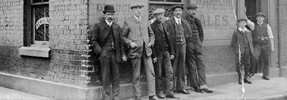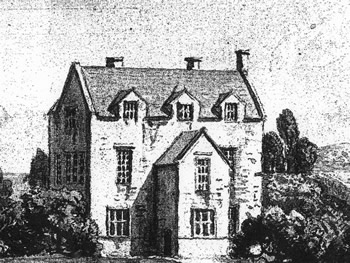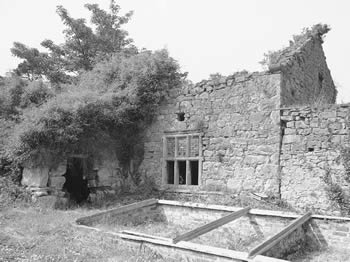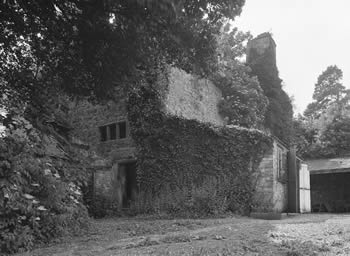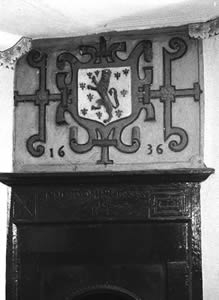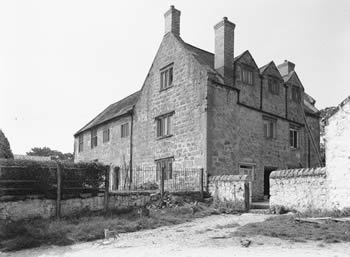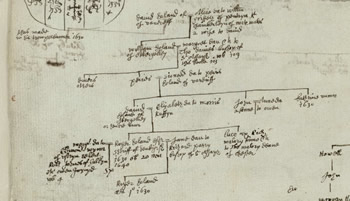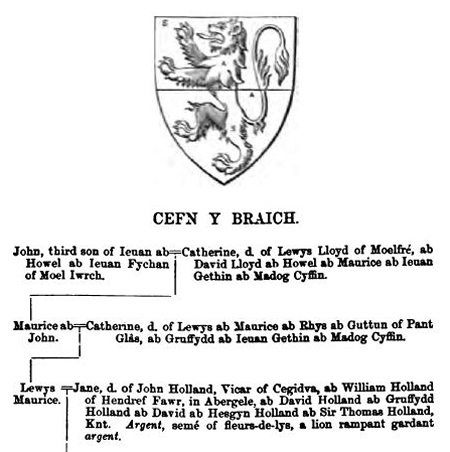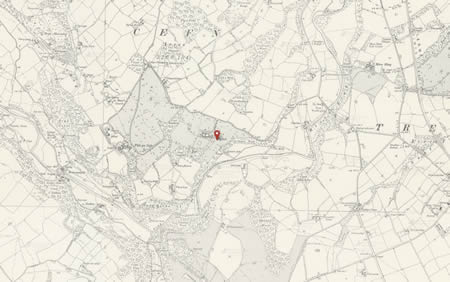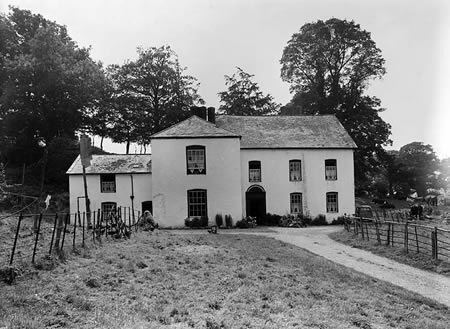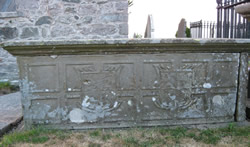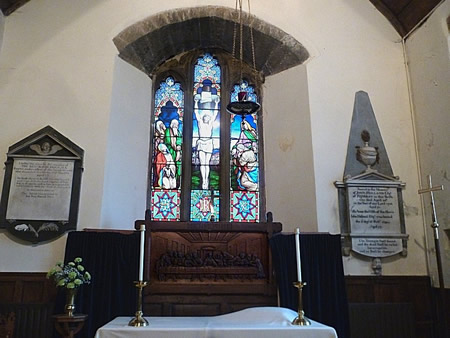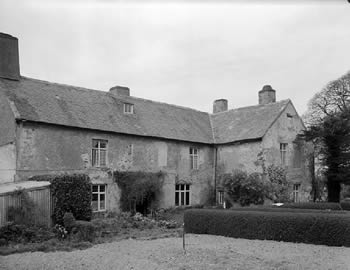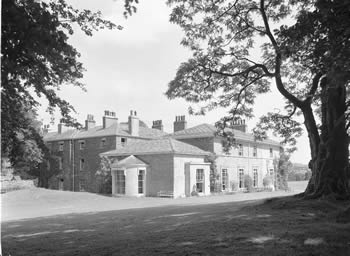The Hollands of Kinmel & Hendrefawr
Griffith Pedigree
A photograph of the Hendrefawr & Kinmel Hollands pedigree page contained in Griffith's Pedigree can be seen by clicking on the link here (courtesy of Flintshire Archives). The physical size of the chart is about A3 and it can be difficult to navigate visually.
As part of my research I have extended the scope of Griffith's original using primary and secondary records where available.
Searchable Database
A fully searchable database of this extended pedigree which includes images of some of the source material used can be accessed by clicking here ![]() . This version will be more convenient for those looking to find a specific name. Click on "Search" or "Surname Index" as appropriate.
. This version will be more convenient for those looking to find a specific name. Click on "Search" or "Surname Index" as appropriate.
An alternative HTML version extracted from the pedigree can be seen here ![]() which will open a new page in your browser. Just close that page to return here. To start navigating backwards through the descendants of Thomas Holland, just click on his name. For those who are used to browsing with two tabs open you can easily compare the pedigree and html versions by switching between them.
which will open a new page in your browser. Just close that page to return here. To start navigating backwards through the descendants of Thomas Holland, just click on his name. For those who are used to browsing with two tabs open you can easily compare the pedigree and html versions by switching between them.
The Hollands of Kinmel, Abergele, Wigfair & Hendrefawr by Brian Holland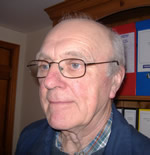
The Lordship of Denbigh was created in 1284 following the defeat of the Welsh princes by Edward 1 in 1282. The Lordship was first held by Sir Henry de Lacy, 3rd Earl of Lincoln who died in 1311. In 1284, de Lacy granted leases to portions of his demesne to a number of English families e.g. Chambres, Peakes, Pigots, Lathoms, Heatons, and many others. He also obtained a 'Charter of Incorporation' which conferred freedom from all tolls for the English settlers living within the Lordship of Denbigh. Few Welshmen, who were known as 'foreigners', received any of these privileges. Henry de Lacy had no male heir, an Inquest Post Mortem was held which resulted in his daughter Alice being granted tenure of the Lordship which she held until 1322, at which time she was imprisoned and her lands confiscated. The Lordship of Denbigh was then given to Hugh le Despenser which he held until 1366, at which point he fell out of favour and the Lordship transferred to Roger Mortimer 1st Earl of Marche, who in turn forfeited it for treason in 1330. In 1331, Edward III granted it to William Montagu, 1st Earl of Salisbury, as a reward for his assistance in overthrowing Mortimer. To make good his title to the lordship, Montagu had to pay substantial compensation to Lancaster's widow and the Despenser family. In 1354, Mortimer’s grandson succeeded, in a court case against Montague’s son, in having the lordship returned to his family. The basis of the decision was that the Montagus did not have lawful title to the lordship following the reversal of the 1330 attainder of Mortimer's grandfather. The Montagus refused to accept the decision and continued to fight, unsuccessfully, for the return of the lordship until at least 1397. The contest between the Montagus and the Mortimers over the lordship of Denbigh became one of the most celebrated aristocratic land disputes of the 14th century.
Roger Mortimer, 4th Earl of March, took over the Lordship in 1381 and held it until 1398. He was married to Eleanora Holland daughter of Thomas Holland the 2nd Earl of Kent by his wife Alice Fitzalan. Their son Edmund Mortimer took over the Lordship on the death of his father in 1398 and held it until his own death in 1425. As he had no heirs the Lordship passed to his nephew Richard Duke of York, the son of his sister Anne Mortimer. Edmund Mortimer’s Widow, Anne, d/o Edmund Stafford, married in 1427, John Holland, 2nd Duke of Exeter, nephew of Thomas Holland 2nd Earl of Kent.
On Richard's death in 1460, his son, Edward of York, inherited the lordship and his father's claim to the throne. When he became king in 1461, as Edward IV, the lordship of Denbigh was united with the crown.
The extent of the Lordship is described in “The Medieval History of the Lordship of Denbigh” by John Wilson and published in 1860 (archive.org), which includes extracts from the Inquisition Post Mortem of Henry de Lacy in 1311, and a 1334 survey by Hugh de Beckele. At that time the Lordship included the main Demesne, the Manor, Dinorben Fawr, together with the Parishes of Abergele and St George, the Hamlet of Kinmel and the Township if Wickwere (Wigfair). Dinorben Fawr included the hamlet of Mayrdreve (Vardre or Y Faerdref).
“The Manor of Dinorben Fawr- The site of the manor of Dinorbyn, in which there is one good grange, and another almost laid waste, except the green enclosure, one granary or barn, and one byre or cowhouse, and one dilapidated shed for hay or forage, containing altogether 2 acres and 1 perch and the easements of the houses and court are worth 5s. per annum. And there is one ruinous dovecot here, which if required, would be worth 6s 8d per annum. Total 11s.6d. The whole of the arable land was 243 acres 3.5 roods 15 perches, which was worth £13 11s 5d per annum; meadow land 22 acres 33 perches, worth 60s. 8d. Other pasture 72 acres 32 perches, worth £4 6s 0.25d; waste, called Pendinas, covered with worthless brushwood, 14s. Adam Anneisone, Adam the son of Richard, John de Rothlan (John of Rhuddlan) and Richard del Nant rented 28 acres 1.5 rood, at 33s. 6d a year. Perquisites of the courts 13s. 4d. Total value of the manor, £24 10s 7.25d per annum”.
The Hamlet of Mayrdreve (Vardre or Y Faerdref)
There was also a certain hamlet called Maynlreve, belonging to the manor of Dynorbyn, which in the time of the princes (pre-1282) was wholly in the hands of bond tenants; and now the occupiers rendered 35s. 10d. annually. And William Cam, John de Rhothlan, John de Pontefract, Robert de Castleford, and others paid 25s. 8d. for 38.25 acres of this hamlet. So the manor aforesaid, with the hamlet was worth £27 17s 1.25d. per annum.
According to the introductory notes to the Kinmel Manuscripts held in the Bangor University Archives, at the date of first extant crown lease of the manor, February 22nd 1534/5, the Holland family was in possession of the demesne of Dinorben Fawr. These notes suggest that Gruffudd ap David ap Robin Holland of Eglwys Bach was first to occupy the demesne and that he built the large demesne farm house, Y Faerdref, which was extant at the time of writing (2017). This house is reputed to have been built on the site of the house previously occupied by Llewelyn ap Iorwerth (1194-1240), Prince of Gwynedd. In “The History of Ancient Tenures of Land in N Wales” (archive.org), the meaning and origin of the term Faerdref or Vardre is described as follows:
“Maerdref” or “y faerdref” (generally shortened to “y fardre” the maerdref) is an important word in the present connection. It does not signify merely the township of the maer, the reeve or bailiff of the lord, but in its strict and ancient sense it signifies the demesne township over which the maer (bailiff) exercised authority in the supervision of the works and duties owing by the men of the township to their lord. It should however be clearly understood that a maerdref was something more than an ordinary servile township; it was the one township or part of a township in every commote which in a special and exclusive sense belonged to the Lord, but in later times the name was loosely used for the home or dairy farm of a large estate.
So with the name “Maerdy”, often corrupted to “Mardy” (the maer’s house), it probably designated the house or dairy farm which the maer (bailiff) of the maerdref occupied during his term of office, and the custom of “maeroniath”, or supply of milk for the lord’s use-----. As already said the maerdref was not originally a farm on an estate; it was that particular tract of land in the commote which in a special sense belonged to the lord of the commote and was always within or near the Lord’s “Llys”or official residence”.
Gruffudd Holland was born circa 1410 and would have come of age circa 1430. It therefore seems likely that Richard Duke of York was the Lord of Denbigh, and therefore Dinorben Fawr, at the time that Gruffudd was in tenure at Y Faerdre. It is conceivable that his father David Holland may have secured the tenure either in Richard Duke of York’s term of office, or during Edmund Mortimer’s term of office. Distant family connections may have worked in their favour during the appointments of English officials and the distribution of lands post the 1282 conquest of Wales. The Holland family held the land in tenure from the Crown for approximately 200 years until it was eventually bought by David Holland, the great, great grandson of Gruffudd Holland for the sum of £512 13s. 4d in 1614 during the reign of Charles 1st.
In addition to the Dinorben Fawr estate the Holland family progressively acquired land in the townships of Towyn, Gwrych, Hendregyda, Bodtegwel, and Boderyn thus securing virtual dominion over the Parish of Abergele. Additional lands were acquired in the Parish of St George. The family progressively branched out into four main lines, these being the main line of Y Faerdre which eventually included Old Kinmel, Hendrefawr in the Parish of St George, Teirdan in Llanelion Yn Rhos and Wigfair (Wickwer) in the Parish of Llanelwy (St Asaph). There was also a minor offshoot at Guilsford, Montgomeryshire.
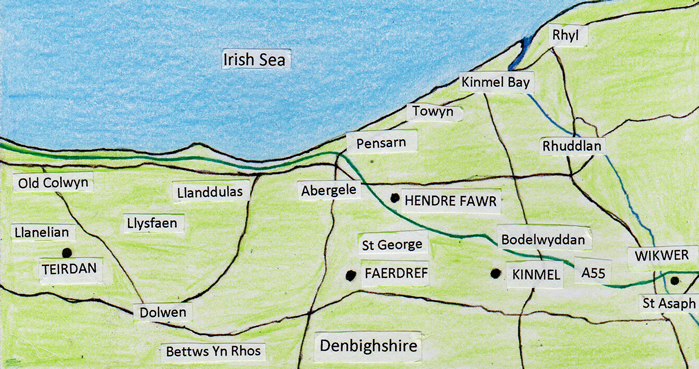 |
| Locations of Kinmel, Abergele, Wigfair & Hendrefawr Holland family in N.E. Wales |
The Kinmel and Dinorben estates eventually went out of the Holland family due to lack of a male heir. Mary and Elizabeth, the daughters and co-heirs of David ap Piers ap David ap Piers ap John ap Dafydd ap Gruffudd, each inherited a portion of the estate which in turn went to their respective spouses William Price of Rhiwlas and Colonel John Carter, military ruler of Conwy Castle, in 1641 and 1647 respectively. Details of each of the main lines of descent from Gruffudd Holland are covered separately below. Several of the descendants held influential positions in Denbighshire and these are covered under the individuals in the evolving pedigree. There are various sources of pedigrees relating to this branch of the Holland family, these include The Visitations of Wales by Lewis Dwnn, The pedigrees of Anglesey and Caernarfonshire Families by J E Griffith, Powys Fadog, The Heart of Northern Wales by W Bezant Lowe, Y Cwtta Cyfarwydd and Welsh Genealogies AD1400-1500 by P C Bartrum; plus various miscellaneous pedigrees in the National Library of Wales (NLW). The Coed Coch papers in the NLW and the Kinmel papers in Bangor University archives are also a valuable source of data. Isabella, a great granddaughter of Gruffudd Holland, married Rhys ap Jenkin ap Llewelyn ap Thomas of Trofarth, from whence came the Wynne Family of Trovarth and Coed Coch.
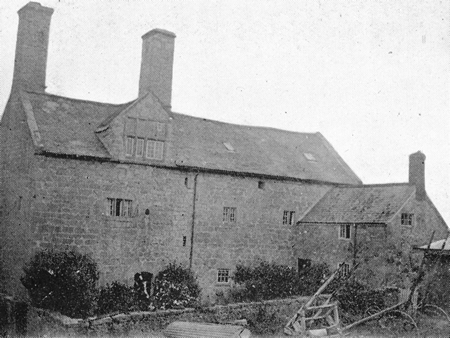 |
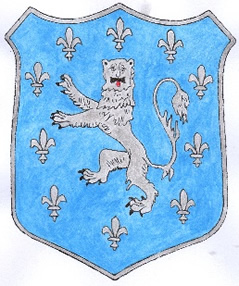 |
|
| Vardre Near Abergele | Coat of Arms |
A description of the mansion house of Y Fardre (Vardre) pictured above, as it was in 1927, is given in “The House of Northern Wales” Vol 2. P345. It is believed to have been built in the 15th century by Gruffudd Holland on the site of an old dwelling which is believed to have belonged to Llewelyn ap Iorwerth. Y Faerdre is still extant in 2016, and lies off a narrow lane due North of Moelfre, and West of Kinmel Park. The house was in the possession of the Holland family until, due to the lack of a male heir, it transferred to Sir John Carter via his marriage to co heiress Mary Holland, a 7th generation descendant of Gruffudd Holland. The main line of descent of Y Faerdref is given below.
David Holland, b circa 1390.
In the Visitation of Wales by Lewys Dwyn (Vol 2 P337), David Holland (Holant) is described as the 2nd son of Robin ap Hoesgyn Holland. David’s brother Hywel Holland succeeded to the Eglwys Bach estate of Plas Pennant, hence it is reasonable to assume that David would have been a candidate for the tenure of the Dinorben demesne, however there is no evidence to support this assumption. David married Dyddgu fch Dafydd Crach and his wife Lleucu fch Dicwn Holland, one of the sons of Trystan Holland, constable of Criccieth Castle and Captain of Harlech. The Gfs and Visitation pedigrees attribute only one son to David Holland, he being the son and heir Gruffudd. However, P C Bartrum (Holland1) attributes 6 children to David and Lleucu, 2 of these, Syr John and No Name (NN) lack credibility, as there is no reference to their origin. A comprehensive hand drawn pedigree showing the descendants of David Holland can be seen by clicking here.
| Margaret ap Dafydd Holland b circa 1420, married Hywel ap Rhys Gethin, descended from Gruffudd ap Dafydd Goch of Penmachno (Gruffudd ap Cynan 6). | ||
| Llewelyn ap Dafydd Holland b circa 1420. | ||
 |
According to the Dictionary of Welsh biography he was the youngest son of Dafydd. He married Angharad fch Einion, great-great-great granddaughter of Iorwerth ap Heilin (Y Penwyn) of Bettws, descended from Ednyfed Fychan (Marchudd 26, Gfs p184 & 376)). Angharad was the niece of Angharad fch Hoesgyn Holland and first cousin of the descendants of Hywel Holland and Lleucu fch Gruffudd. Llewelyn and Angharad had four children: | |
| Dafydd ap Llewelyn Holland, b circa 1450, who married Mali fch Llewelyn ap Dicws ap Rhirid, they had a daughter Gwenllian who married Rhys Ddu; | ||
| Efa fch Llewelyn Holland, b circa 1450, who married Madog ap Rhys (Hedd 2A), they had a son Ieuan who had several descendants in Isaled. | ||
Ieuan Sais ap Llewelyn Holland, b circa 1450 who married Gwladus fch Llewelyn Fychan ap Dafydd Llwyd ap Dafydd. (Edwin 6B). Ieuan and Gwladus had two sons: Grigor ap Ieuan Sais Holland, b circa 1480, who also married Gwladus fch Llewelyn Fychan of Betws (Marchudd 18B) and they had one son Ieuan Holland of whom there is no further information; Gruffudd ap Ieuan Sais Holland, b circa 1480, who married Angharad fch Madog ap Ieuan Gannaid, descended from Sir Robert Poundling of Dyserth, Tegeingl. (Powderling 1B), they had three sons Grigor, Thomas and Dafydd, of whom there is no further information. Gruffudd and his three sons are assumed to be of Tremeirchion in Tegeingl (Peniarth113). |
||
| Lewis ap Llewelyn ap Dafydd Holland. b circa 1460. He appears in a pedigree in Archaeologia Cambrensis 1867, p171, although there is no reference to the origin of the data. He had a son Robert Holland who was married to a daughter of Pain (Payne) of Denbigh, and they in turn had a son Hugh Holland, b 1569, d 1633 who was a well renowned poet of his day and his life is described in the National Biography: | ||
| HOLLAND, HUGH (d. 1633) poet, a native of Denbigh, son of Robert Holland, was a queen's scholar at Westminster School, under Camden, was elected to Trinity College, Cambridge, in 1589, and became fellow there. On leaving Cambridge he went abroad, travelling as far as Jerusalem. It was insinuated that he was made a knight of the Sepulchre; he certainly embraced the Roman catholic faith, and suffered in some way at Rome for indulging in free expressions concerning Queen Elizabeth. On his return to England he expected to receive preferment; not getting it, ‘he grumbled out the rest of his life in visible discontentment’ (FULLER). Wood says that he spent some years at Oxford after his return. From the dedicatory address before his ‘Cypres Garland,’ 1625, we learn that he had been patronised by George Villiers, duke of Buckingham, who had introduced him to King James. In the course of that poem he alludes to his own troubles and bereavements, and the deaths of his mother, whose maiden name was ‘Payne,’ of ‘Ursula’, his wife, the widow of Robert Woodard of Burnham, Buckinghamshire, and of ‘Phil my daughter.’ Holland died in 1633, and was buried in Westminster Abbey (23 July). Aubrey states, on the authority of Sir John Penruddock, that he found a patroness in Lady Elizabeth Hatton, second wife of Sir Edward Coke. Holland is chiefly remembered as the author of an indifferent sonnet prefixed to the first Shakespeare folio (1623). He was a member of the Mermaid Club, and may have been personally acquainted with Shakespeare. Edward Phillips (‘Theatrum Poetarum’) speaks of him as ‘a poetical writer thought worthy by some to be mentioned with Spenser, Sidney, and other the chief of English poets; with whom nevertheless he must needs be confessed inferior both in poetic fame and merit.’ Joseph Hunter pointed out that Phillips here refers to the exaggerated estimate of Holland entertained by John Lane (the friend of Milton and Phillips), set forth in ‘Triton's Triumph,’ a poem preserved in manuscript both in the British Museum and Cambridge University Library. Lane also commends Holland's critical ability. In 1603 Holland published ‘Pancharis: the first Booke. Containing the Preparation of the Love between Owen Tudyr and the Queene, long since intended to her Maiden Majestie: and now dedicated to the Invincible James,’ 8vo (Bodleian); and in 1625 ‘A Cypres Garland. For the Sacred Forehead of our late Soveraigne King James,’ 4to, which he dedicated to the Duke of Buckingham. He contributed commendatory verses to Farnaby's ‘Canzonets,’ 1598; Ben Jonson's ‘Sejanus,’ 1605; Bolton's ‘Elements of Armory,’ 1610 (he was nominated a member of Bolton's projected Academ. Royal); Coryate's ‘The Odcombian Banquet,’ 1611; ‘Parthenia,’ 1611; Sir Thomas Hawkins's translation of selected odes of Horace, 1625; and Alabaster's ‘Roxana,’ 1632. In Lansdowne MS. 777 is preserved an epitaph on Henry, prince of Wales, and he has verses in Harleian MSS. 3910 and 6917. Letters to Sir Robert Cotton are in Cotton MS. Julius, C. iii. (15). In Raymond's ‘Itinerary. Containing a Voyage made through Italy,’ 1648, are some Latin verses by Holland on Sannazaro, and in Hacket's life of Archbishop Williams is an epitaph on Archbishop Mountaigne of York. Fuller states that Holland left in manuscript ‘Verses in Description of the Chief Cities of Europe,’ chronicles of Queen Elizabeth's reign, and a life of William Camden. | ||
| The following chart includes his details from his time at Cambridge University: A Cambridge Alumni Database. University of Cambridge. |
||
| Enhanced version of original printed entry | Encoded version: searched-for items red; some Appendix and Addenda included; unique identifier HLNT590H | |
| Hugh HOLLAND Alias: Hugh ROBERTS Scholar of TRINITY, 1590, from Westminster [ London ]. S. of Robert, of Wales. B.A. 1593/4; M.A. 1597, as 'Robert.' Became a Romanist. Travelled to Rome [Italy], Jerusalem [Palestine] and Constantinople [Turkey]. Resided for a time at Balliol, Oxford [Oxfordshire], after his return to England. Patronised by Buckingham. A member of the Mermaid Club. Wrote the Sonnet prefixed to the first Shakespeare folio. Latin and English poet.'Of Westminster [ London], widower,' at his burial in the abbey;[Buried at Westminster Abbey, London], 23 Jul., 1633. ( D.N.B. ; Al. Westmon. ) |
Hugh HOLLAND Patronised by Buckingham. A member of the Mermaid Club. Wrote the Sonnet prefixed to the first Shakespeare folio Latin and English poet. 'of Westminster, [ London ] widower,' at his burial in the abbey [Buried at Westminster Abbey], [ London ] 1633:07:23 ( D.N.B. ; Al. Westmon. ) |
|
It would appear that Hugh was married to Ursula the widow of Robert Burnham who predeceased him. They had a daughter Phil of whom there is no further detail, according to Wikipedia they had three children but there is no reference given. There is an above average age gap between the birth of Hugh (1569), and his great-grandfather Dafydd (1390) which equates to 45 years per generation rather than the typical average of 30 years. As Llewelyn was the youngest son of Dafydd he could have been born later than assumed, similarly Hugh’s grandfather Lewis may have been the youngest son of Llewelyn.
It is plausible that there were further male descendants from these three sons of Gruffudd ap Ieuan ap Llewelyn ap David Holland, however to date none of these have emerged.
Ieuan ap Dafydd Holland b circa 1420, there is no mention of Ieuan in either the Gfs or Visitation pedigrees, probably because they were not in the main line of descent. Information is provided in the PCB pedigrees, (Holland 5). He married Jane fch Dafydd ap Hywel Coetmore in 1475 and by her had two children: |
|||
Lleucu fch Ieuan ap Dafydd Holland b circa 1450 who married Gronwy ap Llywelyn and they had a daughter Mali who married Gruffudd ap Einion. (Arthen 3) |
|||
Gruffudd ap Ieuan ap Dafydd Holland, b circa 1450, who married Annes fch Jenkin Holland of Denbigh. The precise origins of this Jenkin Holland are unknown but are referenced as being from Peniarth MSS 135. Gruffudd and Annes had five children: |
|||
Margaret fch Gruffudd ap Ieuan ap Dafydd, b circa 1480, was the 2nd wife of Owain ap John and they had one son Richard (Marchudd 22A4) |
|||
Angharad fch Gruffudd ap Ieuan ap Dafydd, b circa 1480, married Ieuan ap Rhys (Llywarch Holbwrch 7B). |
|||
Angharad fch Gruffudd ap Ieuan ap Dafydd, b circa 1480, married Llewelyn Fychan ap Gronwy (Marchudd 3 F1). |
|||
| Isabella fch Gruffudd ap Ieuan ap Dafydd, b circa 1480, married Rhys ap Jenkin (Marchudd 18E). They had a son Dafydd ap Rhys ap Jenkin, b circa 1510, he married Elen fch John from whom descended the Wynnes of Trofarth and coed Coch. | |||
| David ap Gruffudd ap Ieuan ap Dafydd, b circa 1480. He does not appear in any of the published pedigrees but we know of his existence from the Coed Coch MSS: | |||
| Coed Coch and Trovarth Estate Records: Quitclaim by David son of Gruffith ap Ieuan ap David Holand, to Isabella his sister, wife of Rees ap Jankyn ..., Description: Quitclaim by David son of Gruffith ap Ieuan ap David Holand, to Isabella his sister, wife of Rees ap Jankyn ap Llewellyn, of right to two places on the road leading from the Town of Dynbiegh towards Henllan; 18d. yearly rent to be paid to the chief lord. Witnesses: - Henry Heton, senior;John Heton, senior, Thomas Grimesdyche. Dated at Dynbiegh. Related Titles:Coed Coch and Trovarth Estate Records, Creation Date: 1489, July 27. | |||
The above data is given credibility by the existence of several deeds within the Coed Coch MSS (NLW) referring to land transactions between Gruffudd Holland and Rhys ap Jenkin and Isabella his wife viz:
Coed Coch and Trovarth Estate Records: Grant by Gruffith ap Ievan ap David Holland, Burgess of the town of Abergele, to Res ap Jankyn ap Llewelyn ...,
Description: Grant by Gruffith ap Ievan ap David Holland, Burgess of the town of Abergele, to Res ap Jankyn ap Llewelyn and Isabella his wife, daughter of the grantor, of right in the comote of Istulas in the lordship of Denbyght which he had in exchange and in the name of "tir prid" from David ap Ievan ap Howell, in the lands and tenements late belonging to Ievan Dduy ap Ievan Tewe. Witnesses: David Holand the younger, Gruffith ap Meredith ap Tuder, etc. Dated at Abergele. Seal, initial letter G.
Related Titles: Coed Coch and Trovarth Estate Records, Creation Date: 1523, Aug. 23.
By virtue of the date of 1523, David Holand the younger cannot be David ap Gruffudd Holland who by this time was deceased. It could therefore be either Dafydd ap Llewelyn ap Dafydd, or Dafydd ap Jenkin Holland.
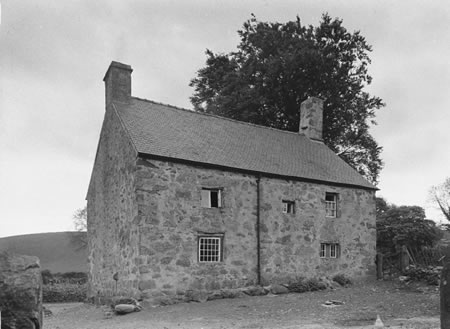 |
A mansion house named Plas Yn Trofarth was the family residence of the Wynne family of Coed Coch and dates back to the 16th century. It was probably built by Rhys ap Jenkin or one of his immediate descendants. The township of Trofarth was in the commote of Is Dulas and Cantref of Rhos, now Bettws Yn Rhos. A complete description of the property is given in a publication by “Discovery of Old Welsh Houses - PLas Yn Trofarth” which also gives the origins and family history of the Wynnes of Trofarth and Coed Coch and their descent from the marriage of Rhys ap Jenkin and Isabella fch Gruffudd ap Ieuan ap Dafydd ap Robin Holland. It is interesting that the Wynne family eventually acquired the Teyrdan estate in the neighbouring parish of Llaneilian yn Rhos via the marriage of Mary, the sole heiress of John Holland of Teirdan, a direct descendent of Isabella’s great grandfather Gruffudd ap Robin Holland. Rhys ap Jenkin’s grandsons were the first in this line to abandon the patronymic surnames and adopted the surname Wynne.
The ancestors of the Wynne family were amongst those who acquired leases for land within the Lordship of Denbigh. The following land transaction was carried out during the reign of Henry VII. (1.) Rhys ap Jenkyn, of Trebyll (Llansanffraid G.C.) and Betws, is the first of the family to be mentioned. He was married to (2.) Isabella, daughter of Gruffith ap Ieuan ap David Holland of Abergele. According to “Plas Yn Trofarth, (page 11),” Isabella’s grandfather, Ieuan, had married in 1475, Gwen, d/o David ap Howell Coetmore the knight of Betws whose stone figure is now in the church of Llanrwst, however this is not featured in the Bartrum pedigrees and the origin of the data is unknown. The dates also look somewhat dubious as Hywell Coetmore died in 1388, eighty-seven years before the marriage of his granddaughter.
Dated at Dynbiegh, 1 March. 9 Hen. VII. [A.D. 1494.] - Lease by John Scaltok, burgess of the town of Dynbiegh, to (1a.)Isabella, daughter of Gruffith ap Ieuan ap David Holond, wife of (1.)Res ap Jenkyn ap Llewellyn, of two pieces of land within the franchise of the said town in "Le Foren", i.e., the forensic (the Welsh part of the town – sometimes called Abergele Walican) or outer part between the High street and the stream called Pedlere Siche, etc., for 40 years at an annual rent of 2sh. 6d., and so from 40 years to 40 years at option of the lessee.
Gruffudd ap Dafydd Holland b circa 1420.
Gruffudd Holland of Faerdref was the heir of Dafydd ap Robin Holland. In the Gfs and Visitation pedigrees he is only attributed one wife, Gwerfyl Fechan fch Hywel ap Madog ap Ieuan, descended from Collwyn ap Tango, however in P C Bartrum (Holland 3) he had two other wives, Lleucu fch Gruffudd descended from Ithel Goch (Hedd 2), and No Name (NN) fch Lewelyn Gethin. From these three marriages Gruffudd had a total of twelve children (Holland 3). From Gwerful Fechan he had his heir Dafydd, Catrin, Margared and Morfudd. From Lleucu he had Lleucu, and from NN fch Llewelyn Gethin he had Mali. The other four children attributed to him were Margared, Sander, Llewelyn and Rowling, however, the mothers of these are not attributed.
| Catrin fch Gruffudd ap Dafydd, b circa 1450-60. She married Howel ap Llewelyn Fychan of Lleweni (Edwin 6 D1), there was no known issue. | |
Margared fch Gruffudd ap Dafydd,b circa 1450-60. She married Gruffudd ap Meredydd, (Llewelyn Eurdorchog 1A) no known issue. |
|
| Lleucu fch Gruffudd ap Dafydd, b circa 1450-60. She married Dafydd ap Rhys ap Llewelyn ap Thomas the first cousin of Rhys ap Jenkin, husband of Isabella ap Gruffudd ap Ieuan. They had two daughters Lleucu and Ellen. (Marchudd 18E). | |
Morfudd fch Gruffudd ap Dafydd, b circa 1450-60. She married Dafydd ap Llewelyn and they had one son Rhys (Dafydd ap Llywarch B), the descent beyond Rhys is not shown but is listed as Dyserth, Llansanfraid Glan Conwy, Uwch Dulas (Peniarth 136 MSS-74). |
|
Mali fch Gruffudd ap Dafydd, b circa 1450-60. She married Rhys ap Robin ap Dafydd Llwyd ap Cynwrig Moel of Carredfynydd, living in 1334 (Marchweithian 5). They had a son Gruffudd who in turn had ten children in Llanfair Talhearn and Carredfynydd. |
|
Margared fch Gruffudd ap Dafydd, b circa 1450-60. She married Hywel ap Dafydd and had a daughter Catrin. |
|
Sander ap Gruffudd ap Dafydd, b circa 1450-60. He is thought to have married Alice fch Thomas ap Jenkin ap Hywel Pigot who died in 1476. There are no descendants listed. There exists a deed in the Kinmel papers (Bangor Uni) dated August 16th 1508 in which Sandro ap Gruffudd ap Dafydd Holland is involved in the feoffment of two parcels of land in Abergele. This is followed up by a deed dated 9th May 1509 where Sandro ap Gruffudd ap Dafydd Holland is named as a free tenant in the township of Abergele involving the “feoffment of one parcel of arable land in the township of Abergele in breadth between the lands of Griffith ap Meredith ap Tudur on the North part, and the lands of David ap Gruffudd ap David Holland on the east part, and in length between the lands of Griffith ap Meredith ap Tudur on the south side and the common of the township on the west part near Fynon Yglogrwen” |
|
Llewelyn ap Gruffudd ap Dafydd, b circa 1450-60. He married Alice fch Hywel ap Rhys Gethin, (Marchweithian 3G), they are attributed three sons: Dafydd, Hywel and Gruffudd of whom nothing else is known. |
|
Rowling ap Gruffudd ap Dafydd, b circa 1450-60. There is no spouse or any other reference listed. He is attributed two children: Gwen and Hywel of whom nothing else is known. (Holland 3). |
There are references within the Wynnstay Estate papers to land transactions involving Gruffudd Holland as summarised below, these MSS have not been viewed by myself.
Title: Wynnstay Estate Records: Abergele town,
Description: Title deeds for properties in the town of Abergele in Denbighshire, several of which describe the acquisition of burgages and curtilages through lease, purchase and quitclaim by William Pyget, 1359, Robert de Holand, 1359, and Gruffith ap David Holand, 1439-1479; the remainder comprise various types of long-term leases by Isabella, wife of Robert de Holand, 1415, and David ap Gruffith ap David Holand, 1494-1512. Most of the deeds describe detailed boundary clauses and landmarks, including Abergele high street, the parish church, and the rivers Fulbrock and Geley.
Related Titles: Wynnstay Estate Records, Creation Date: 1359-1512.
Dafydd ap Gruffudd ap Dafydd Holland, b circa 1450.
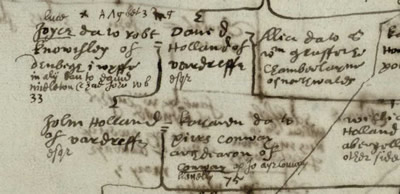 |
||
| Harleian Mss 577 | ||
David was the son & heir of Gruffudd of Faerdref. The Gfs, Visitation and Powys Fadog pedigrees attribute to him two wives. First Luce (Joyce) fch Robert Knowsley of Denbigh, and second Ales (Alice) fch Sir William Griffith, Knight of Penrhyn. The P C Bartrum pedigree attributes to him three wives, 1st Elsbeth fch David Middleton Hen (Rhirid Flaidd 2B), 2nd Alice fch Sir William Griffith and 3rd Margared fch Thomas ap Rhys ap Robin Talbot of Abergele (Salesbury 12). The references in Salisbury 12 make no sense so have been ignored in the pedigree. This extract from Harleian MSS 1571 of the Faerdref pedigree (see right) appears to confirm his wife as Joyce fch Robert Knowsley, but makes an undecipherable reference to the daughter of David Middleton. Perhaps this is the source of the confusion, it therefore seems safe to assume that Joyce was his 1st wife.
There is inconsistency between the various pedigrees regarding the number of children attributed to David. P C Bartrum attributes four children in total from his various wives. He had a son and heir John by Joyce, a son William and daughter Grace by Alice and a daughter Angharad via Margared, she married Gruffudd ap Meredydd. He also tentatively assumes that he had a son Gruffudd of Tegeingl, however as no references are given I have chosen not to include it in the pedigree. He is also believed to have had a son Richard (Arch. Camb. Vol V111, 3rd Series, 1867, p171 pedigree and Harley 1971)) of whom nothing is known.
Joyce was the daughter of Robert Knowsley of Abergele, little is known about him, however, there are several references in the Kinmel MSS (NLW) to land transactions in Abergele involving the family of Knowsley in the 16th century, it therefore seems probable that he was their ancestor. Gruffudd and Joyce had one son John who became heir to the Faerdref estate.
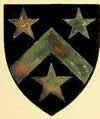 |
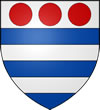 |
Alice was the daughter of Sir William Griffith of Penrhyn, b circa 1445, d1505 (Marchudd 6B3) by his second wife Elizabeth fch Robert Grey, Constable of Ruthin, son of Sir Reginald Grey 3rd baron Grey of Ruthin and his second wife Joan of Astley. Elizabeth was therefore first cousin to John Grey, lord Ferrers of Groby (1432 - 1461) who was the first husband of Elizabeth Woodville, later queen of Edward IV. The marriage must have brought Sir William Griffith into personal contact with the powerful Greys and Woodvilles, and it would explain his presence as member of Edward IV 's council on 8 Aug. 1482. Robert Grey was also the brother of Sir John Grey by Reginald’s first wife Margaret of Roos, he married Constance the daughter of John Holland 1st Duke of Exeter, therefore Elizabeth was a niece of John Holland’s step-brother King Richard 11. William Griffith held the position of Chamberlain of N Wales and was knighted in 1489. Alice was very well connected and no doubt considered an excellent match for Dafydd, she had been previously married to Piers ap Rhys ap Robert ap Ieuan Fychan of Coetmor, they had four children, Elen, Robert, Myfanwy and William Coetmore, of Coetmor, Llanllechid, Arllechwedd Uchaf, who was alive in 1538 (Iarddur 3, Gfs 277). Since Dafydd was born circa 1450, Alice must have been quite a bit younger than him, he must therefore have been middle-aged before he married. They had three children, Grace, William who was the founder of the Hendrefawr Estate, and Richard.
| Grace fch Dafydd ap Gruffudd, b circa 1480, she married George ap Robert ap Sir Thomas Salesbury (Salesbury 4). No children are attributed to them. | ||
| William Holland ap Dafydd ap Gruffudd, b circa 1500, d1588. 2nd son of Dafydd Holland and founder of the Hendre Fawr Estate. (See below under Hendre Fawr). | ||
| Richard Holland ap Dafydd ap Gruffudd, b circa 1495. Evidence for him appears on the Har. MSS 1971 pedigree and in Arch Camb 1867. There are no further details relating to him. | ||
| There are three deeds in the Kinmel papers at Bangor Uni Archives (BUA) referring to land transactions in Abergele involving David Holland, son and heir of Gruffudd ap David Holland, the latest of these is dated 1517. | ||
John ap Dafydd ap Gruffudd ap Dafydd Holland, Esquire, b circa 1480.
John was the son and heir of Dafydd ap Gruffudd and was the successor to the Faerdref and Dinorben Estate. There is very little reference to him in either the Coed Coch or Kinmel papers. He married Catrin fch Piers Conwy (Conwy 4) and according to P C Bartrum they had three children, Piers, John and Jenkin. Catrin married 2nd Grigor ap Gruffudd ap Rhys and they had four children (Ednywain Bendew 4A2), this would seem to suggest that John died at an early age.
| Piers ap John ap Dafydd ap Gruffudd ap Dafydd Holland, Esquire, b circa 1500, d1593. (See below) | ||
| John ap John ap Dafydd ap Gruffudd, b circa 1510. He married Elsbeth fch Llewelyn ap John ap Madog Fychan who had previously been married to Robert ap Tudur ap Robert of Llandulas. There are no children issuing from either marriage. | ||
| Jenkin ap John ap Dafydd ap Gruffudd, b circa 1510. He married Annes fch Dafydd ap Rhys Wyn, there are no known issue. (Marchudd 16B). | ||
Piers ap John ap Dafydd ap Gruffudd ap Dafydd Holland, Esquire, b circa 1500, d1593.
| Piers was the heir to the Faerdref Estate and by his marriage to Catherine, daughter and heiress of Alice fch Gruffudd Llwyd of Kinmel (See pedigree below) he took possession of the neighbouring Kinmel Estate, which gave him a considerable land holding in the Parish of St George. |  |
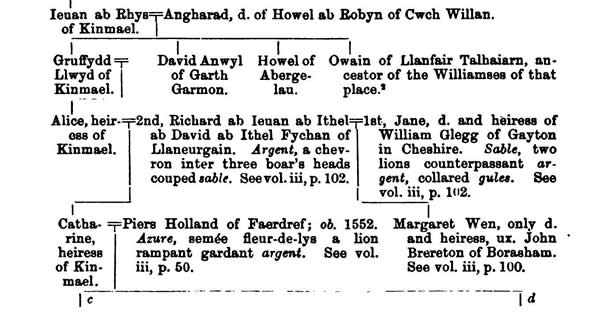 |
According to the Gfs pedigree (p259 above), and repeated elsewhere, Piers died in 1552, this is in fact incorrect and has caused confusion between him and his grandson Piers ap Dafydd Holland who Gfs attributes as being sheriff of Denbighshire in 1578. We know this to be incorrect on two counts: 1- he would have been too young to be sheriff as he was probably born no earlier than 1570; 2- the following extract from Arch Camb, 1869 (p19) confirms Piers ap John ap David Holland as Sheriff in 1578:
| “1578- Pierce Holland of Faerdref, in the Parish of Abergele, Esq.,was the eldest son of John Holland Esq., by Catherine, daughter of Pierce Conway, Archdeacon of St Asaph. He married Catherine, daughter and heiress of Richard ap Ieuan ap David ap Ithel Fychan of Llaneurgain, by his second wife, Alice daughter and heiress of Gruffudd Lloyd of Kinmel, Esq.; descended from Ednyfed Fychan, Baron of Brynffanigl, etc. The Arms of the Lloys of Kinmel were, --- sable, a chev. Inter three mullets, arg., for Rys ap Robert of Kinmael; 2, gules. A chev. Inter three mullets or; for Rotpert of Kinmael; Ednyfed Fychan, gules, a chev. Ermine inter three Englishmen’s heads in profile couped ppr. (16; Marchudd ap Cynan”. |
There are many deeds referring to Piers ap John ap David in the Kinmel, Coed Coch and other estate papers, the earliest of which is dated 1550. As he was heir to John ap David Holland this may imply that David died circa 1550. The following deeds are the most interesting and include references to family connections, the first of which confirms that he was alive in 1579. The Wynnstay Estate papers in the NLW contain some deeds which contain references to the Holland family which have not been reviewed by myself.
| Title: Coed Coch and Trovarth Estate Records: Quitclaim by Peter Holland of Kynmell' alias Kilmaill', co. Denbigh, Esqre., and David Holland, his son and heir, to Humphrey ..., Description: Quitclaim by Peter Holland of Kynmell' alias Kilmaill', co. Denbigh, Esqre., and David Holland, his son and heir, to Humphrey Holland son of the said Peter, of lands tenements etc., in Maesegwick, Kylcken, Llaethven', Bodleuuyn and Towonnan, co, Denbigh. Signature of David Holland. Witnesses: David Llewys, Piers ap Hughe, Elis ap John Amredydd, Ieuan ffoud ap John ap Gruffudd ffoud', Morgan ap Ieuan Vychan. English. Vellum. Related Titles: Coed Coch and Trovarth Estate Records, Creation Date: 1579, July 27. |
The following letter hardly describes Piers as a likeable character:
| Title: Wynn (of Gwydir) Papers: Letter from Katherine Wynn, Gwydir, to her [step]son John Wynn at the Inner Temple, | ||
| Is Part Of: Wynn (of Gwydir) Papers | ||
| Description: Complains that a kinsman and late servant of hers, Jevan ap Thomas ap Kynric, having killed one William ap Rice with a blow from a stone, Jevan Lloid ap David ap Meredith and William Lloid his son conspired with Piers Holland, a malicious enemy of her house, to have her said servant indicted for wilful murder together with one Jevan ap Tudyr as accessory. Her father-in-law Mr Salusbury of Rugge, Mr Thomas Salusbury of Denbigh, and the rest of that crew, promised to be his friends, so that he yielded himself to the law. Having led him as a bear to the stake or as a lamb to the butcher's stall, they now not only leave him destitute of all aid, but have written to Mr Fowllke Lloid, and other of my Lord's officers, to write to my Lord of Leicester to aggravate matters. The evidence in his defence will prove to be but manslaughter, and the surgeon will, upon oath, verify that he died rather of God's visitation, or for want of good keeping, than of the hurt. Besides, the man slain had upon him a good pike fork and a long dagger, and was a stronger man, and her kinsman and servant had but a dagger, and was driven back to a hedge where he found a stone under his feet. Desires Wynn to solicit the aid of her good friend Sir John Hughband in the matter. Her poor son [Wynn's brother-in-law], little Thome Salusbury, will be filled with great perplexity, for he was his father's man and hers, and one whom he tenderly loveth. She is but a woman, foolish and fond, but he [Wynn] is wise, discreet and conversant with those who can best instruct him. Note by Thomas Brook: 'I pray you write unto me your pleasure touching the books of the Quarter Sessions and whether I may have them or not, paying you xxs. for every Sessions.'. Mutilated. [Katherine Wynn or Catherine of Berain was the third wife of Maurice Wynn of Gwydir. John Wynn was the son of Maurice by his first wife]. | ||
| Related Titles: Wynn (of Gwydir) Papers,Creation Date: 1576/7, Feb. 24. | ||
| Title: Coed Coch and Trovarth Estate Records: Memorandum that "Peter Holland of Kynmill, alias Kilmaill, father to David and Humphrey Holland granted a Deed of partition of ..., | ||
| Is Part Of: Coed Coch and Trovarth Estate Records | ||
| Description: Memorandum that "Peter Holland of Kynmill, alias Kilmaill, father to David and Humphrey Holland granted a Deed of partition of part of Teyrdan to Humphrey Holland in 1579, The land was chiefly in Bettws Llaethfaen and Twnan Maessegwyd and Kilkin. He was buried in Llanelian in 1612." English. Paper. | ||
| Related Titles: Coed Coch and Trovarth Estate Records, Creation Date: [?1612]. | ||
| The following grant in “fee simple” enables Piers to pass the tenure on to his heirs. | ||
| Kinmel 686-1574-5; 1- Robert Earl of Leicester, 2-Peter Holland, Gent. | ||
| Grant in fee simple of the capital messuages and lands in Kinmel and Wickwer in the tenure of the said Peter Holland in right of his wife Catherine, messuages and lands in Abergeley and Keygydoche (Cegidoc); a capital messuage and lands in the township of Dynorben Fawr and the Hamlet of Mayrdre (Faerdref), otherwise Vaerdre; and lands in the townships of Hendregyda,Myvott and Wickwer. | ||
| Kinmel 162-1588/9;-1- Peter Holland; 2-Foulk Holland, son of 1 | ||
| Gift of 2 acres of meadow land lying in meadow called Gweirglodd Hendregyda in the township of Hendregyda, between the lands of John ap John David Lloyd on the one side and the lands of William Holland deceased on the other side, and between the meadow of the said Peter Holland called Gweirglodd Y Gasseg------- . | ||
According to Gfs (p259) Piers and Catherine had ten children, as follows: |
||
| David ap Piers ap John ap Dafydd ap Gruffudd ap Dafydd Holland, b circa 1520-25 d1616. As heir, he acquired the Kimnel estate. (See below) | ||
| John ap Piers ap John ap Dafydd ap Gruffudd ap Dafydd Holland, b circa 1520-1525. He acquired the Wigfair estate, Llanelwy (St Asaph). (See separate notes under Wigfair). | ||
| Humphrey ap Piers ap John ap Dafydd ap Gruffudd ap Dafydd Holland, b circa 1527-30. He acquired the Teirdan estate, Llanelian Yn Rhos . (See separate notes under Teyrdan). | ||
| Catherine fch Piers ap John ap Dafydd ap Gruffudd ap Dafydd Holland, b circa 1530-50. Catherine was possibly the eldest daughter. She married Piers Owen of Garth Y Medd (See pedigree below). Piers Owen was the son of John ap Owen and Elen fch Piers Coetmore of Llanllechid, the granddaughter of Sir William Griffith of Penrhyn. There were a number of marriages interconnecting the descendents of Sir William Griffith with the Owens of Garth Y Medd and Hollands of Kinmel. Elen’s mother was Alice fch Sir William Griffith, who later married David ap Gruffudd Holland, Catherine’s great-great- grandfather (see above). Piers Owen’s sister, Catherine fch John ap Owen, married Catherine fch Piers Holland’s brother David, and their sister Jonet married Piers ap William ap Dafydd Holland by his wife Alice fch Sir William Griffith. These interactions are shown on the main pedigree. Piers ap Owen was Sherriff of Denbighshire in 1584 having been proceeded by his father John Owen in 1545. (Arch Camb 1869, p 5, see below). |  |
|
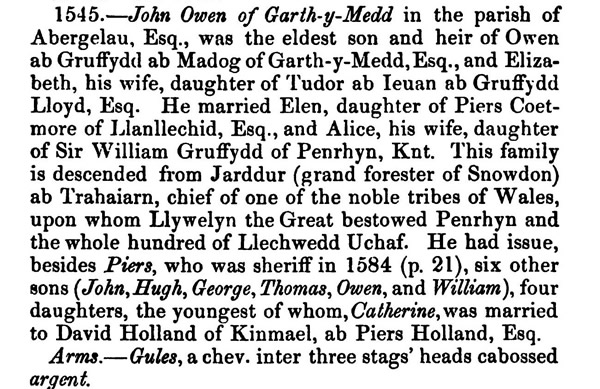 |
||
| Pedigree of Piers Owen of Garth Y Medd (Powys Fadog vol 5, p401) | ||
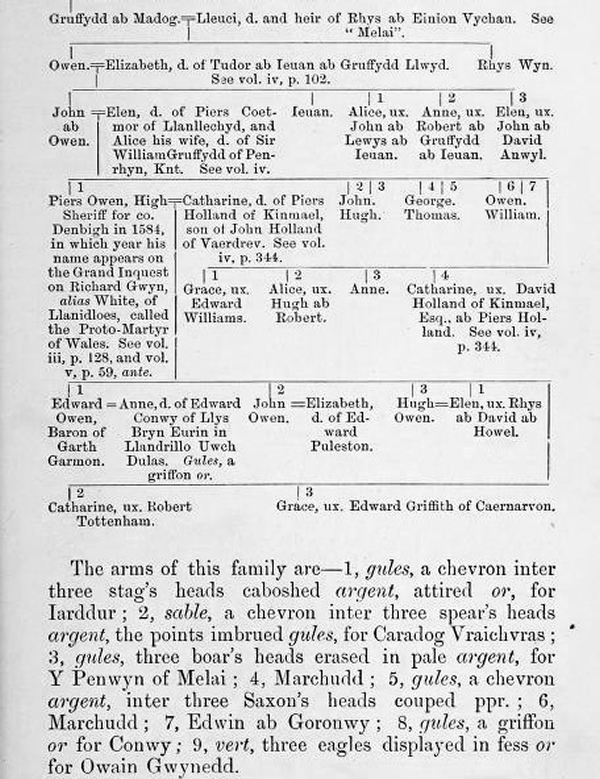 |
||
Piers Owen and Catherine had five children, the most notable of which was Edward Owen, Baron of Garth Garmon, Llanrwst. |
||
| Dows fch Piers ap John ap Dafydd ap Gruffudd ap Dafydd Holland, b circa 1530-50. She reputably married Hugh ap Lewis ap Gruffudd ap Dafydd of Meriadog, Abergele, there is no known issue. | ||
| Piers ap Piers ap John ap Dafydd ap Gruffudd ap Dafydd Holland, b circa 1530-50. There is no information relating to him. | ||
| Grace fch Piers ap John ap Dafydd ap Gruffudd ap Dafydd Holland, b circa 1530-60, d 1624. She married 1st Thomas Salisbury of Carwedfynydd, it is not known whether there was any issue. She married 2nd Foulk ap Robert ap Robert of Plas Newydd, Meriadog, b1540, d1607 descended from Marchweithian; the following deed refers to the post nuptial agreement. | ||
| Title: NLW Deeds: Post-nuptial Settlement of Ffulc ap Robert, son and heir apparent of 1 and Grace Holand, his wife, being a Feoffment ..., | ||
| Description: 1 Robert ap Robert ap Ho'ell. 2 Tuder ap Robert ap Ho'ell and David ap Gruff' ap Ieuan ap Rees. Post-nuptial Settlement of Ffulc ap Robert, son and heir apparent of 1 and Grace Holand, his wife, being a Feoffment To Uses of all 1's m's, lands, tmts, mills, etc., in t. Meiriadog, [p. St Asaph], and elsewhere in co. Denb., to 2, to the use of 1 for life, and after his death to the use of Ffulc ap Robert and his lawful heirs, with remainder to Harry ap Robert, John ap Robert and William ap Robert. Latin. Seal. Endorsed: Livery of seisin, `391' (subsequently deleted), `No. 164'. | ||
Related Titles: NLW Deeds, Creation Date: 1559, Sept. 30. |
||
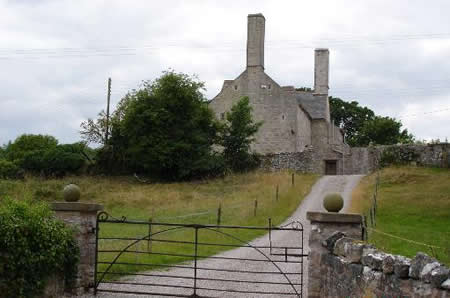 |
They had five children, Piers, Humphrey, Jane who married Owen Holland of Eglwys Bach, Catherine and Ellen. (Heart of Northern Wales, vol 2, p377). Her grandson David Piers Foulk married Catherine daughter of Cadwalader Wynne of Voylas (Voelas) and his wife Anne fch Owen Holland of Plas Berw Anglesey. The three Holland lines of Eglwys Bach, Plas Berw and Kinmel were therefore interconnected by Grace and her descendants. Grace and Foulk lived at Plas Newydd, Meriadog (pictured left) which they built in 1583 and is still extant. Grace was buried at Llenefydd in 1624, her burial is recorded in Cwytta p102. A description of the house and the origins and descent of Piers Foulk are described in (Heart of Northern Wales, vol 2, p371-378). | |
| Plas Newydd Cefnmeiriadog |
Foulk ap Piers ap John ap Dafydd ap Gruffudd ap Dafydd Holland, Gent, b circa 1530-50, d1624. |
|
| In the Kinmel and Mostyn MSS there are a number of deeds relating to land transactions in the township of Hendregyda by Foulk Holland, the earliest of which is date 1558. In these MSS he is variously stated as being of Towyn, Erethlyn (Eglwys Bach) and Towyn and Erethlyn. Presumably he was domiciled in either Towyn or Eglwys Bach or both. In Kinmel MSS 222 he is referred to as Foulk Holland of Erethlyn, Gent, brother of Humphrey Holland of Towyn, Gent. | |
| There is no evidence that he ever married. We know from his will (SA/1624/1) that he died in 1624. Unfortunately, the will is in a poor state with sections missing, however, it is possible to deduce that he had several children out of wedlock to more than one partner, and possibly in more than one parish. | |
| “I will the surplus of my goods cattells and chattels and substance to my Base son Hoell Ffoulk and to John Jones and Robert Jones being my base sons, John Ffoulk and children, to be between them distributed according to the discretion of my executors herein ------- I give and bequeath to my base son John Ffoulk in full consideration----” | |
| He then goes on to appoint his executors: | |
| “Item, I do hereby appoint my loving nephews Piers Holland, Ieuan Lloyd and William Holland to be my executers of this my last will and testament.” | |
| William was the son of Foulk’s brother John Holland of Wickwer, and Piers was the son of his brother David Holland of Faerdref, Ieuan Lloyd is a mystery. Foulk’s request was that he be interred in the parish church of Abergele. He made many other bequests in his will to friends and acquaintances, some of which were for “drinking money”, presumably to his drinking pals. It would appear that he enjoyed the benefits of Gentleman status without the responsibilities of estate management. His burial is recorded in Cwytta p 103: | |
| “Upon Tuesday being xxviiith day of September1624 happening upon a fayor day in Abergele, one Ffoulk Holland brother of David Holland Esq’re deceased was buried in Abergele church where his brother Piers Holland had been buried before, as was alleged”. | |
| Sir Hugh ap Piers ap John ap Dafydd ap Gruffudd ap Dafydd Holland, b circa 1530-50. The only reference to Sir Hugh Holland is in the Gfs pedigree (p259) where it is stated that he was vicar of Llanegryn in 1582, the source of this information is unknown. | |
| Jonet fch Piers ap John ap Dafydd ap Gruffudd ap Dafydd Holland, b circa 1530-60. She married her cousin Piers ap William ap Dafydd ap Gruffudd Holland of Hendre Fawr. Details of their descendants are covered in the Hendre Fawr section. | |
We can conclude that Piers died in 1593 as his will (PROB/11/82/572) was probated that year. Within it he left everything to his son David Holland whom he named as executor. |
|
David ap Piers ap John ap Dafydd ap Gruffudd ap Dafydd Holland, Esquire, b circa 1520-25, d1616.
The following is an from extract from a book entitled “Kinmel Characters 12th-20th Century” (Llandudno Reference Library)” that describes the history of Kinmel.
“From the beginning of the 12th century until the sixteenth, Kinmel was owned by a family who, after eight generations, took the surname Llwyd (Lloyd). In 1872 their coat of arms could still be seen over the fireplace in a fragment that remains of the old hall. One member of this family was Rhys ap Robert who lived in Kinmel c. 1354 and was a renegade Welshman in the service of the King of England”. “A later member of the same family was the celebrated Gruffudd Lloyd whose granddaughter and heiress of Kinmel, Catherine, married into that large wealthy family, the Hollands of nearby Fardre”
Rhys ap Roppert (Robert) of Kinmel was a descendant of the progenitor of the Tudor dynasty, Ednyfed Fychan. He attained several positions in the administration of north Wales, including co- Constable of Flint Castle by 1349, escheator of Caernarfonshire from 1347 to 1350, and rhaglaw (bailiff) of the comote of Dinmael in 1360-61. In 1354 he was fined for taking bribes, and in 1358 the men of Englefield in north-east Wales complained to the Black Prince about Rhys's oppressive measures. Rhys's most important role in Welsh society was as a supporter of Owain Lawgoch, a mercenary in French pay and a claimant to the title of Prince of Wales, who attempted to invade Wales with French support in 1369 and again in 1372. During the latter year, Rhys' son Ieuan Wyn - who also served as a mercenary in France - was identified along with Owain as having received over 500 marks from Rhys to aid their fight against the English there. The allegations seem not to have harmed Rhys's career, as he was appointed chief sergeant of the lordship of Denbigh in 1374, he died in 1377.
There are several deeds in the Kinmel MSS between 1593 and 1616, i.e., between his father’s death and his own death, which refer to land transactions in Abergele by David Holland, Esq. of Kinmel or Faerdref the most interesting of these being as follows:
Kinmel MSS 613- 1610. "I David Holland the younger of HendreFawr, Co. Denbigh, Gent. 2-David Holland of Kinmel";
“Lease for 59 years of parcels of land called Y Genfron, Y Farge, Cae Yr Bulch, Cae Yr Weirglodd, Yr Ardd Vawr, Ker Yr Garrog, and a little parcel of land by the highway side near Nant Y Corr, all being part of the moiety of the manor of Dinorben Fawr demised by the King for 60 years to the said David Holland, which said moiety was sometimes in the tenure of William Holland and late in the tenure of Piers Holland. The said David Holland Esq. by his deed dated13th June, 1610 assigned the premises to David Holland Junior”
Kinmel MSS 614- 1610. “1-David Holland of Kinmel Esq.. 2-William Holland of Wickwer, Gent. and Humphrey Foulk of Eglwys Fach, Gent";
“Lease for 60 years, or for the life of the said David Holland of the parcels of land in MSS 613 were granted to the said David Holland forever”.
Kinmel MSS 617-1610 “Lease for 60 years by letters patent under the Great Seal of King James 1 to David Holland of Kinmel Esq. of the moiety of Dinorben Fawr, formerly in the tenure of William Holland and later on now in the tenure of Peter Holland and one time granted by Robert, Earl of Leicester to one Dorothy Bradwelt, and the other moiety of the said manor formerly in the tenure of Simon Thellwal and later now in the tenure of Robert Holland; and six tenements and lands in Kedidock”.
In Har. MSS 1971, David and Catherine are credited with four children, although not all published pedigrees reflect this:
| Piers ap David ap Piers ap John ap Dafydd ap Gruffudd ap Dafydd Holland, b circa 1560--70, d1643. Heir to the Kinmel Estate (see below). | |
| William ap David ap Piers ap John ap Dafydd ap Gruffudd ap Dafydd Holland, b circa 1565-70. According to the Gfs pedigree he died without issue. It is unlikely that he was the William Holland mentioned in the above deeds, and there are no other references to him. | |
| Dowce fch David ap Piers ap John ap Dafydd ap Gruffudd ap Dafydd Holland, b circa 1565-70. According to Har. 1971 she married William Vaughan of Eyton who was Sheriff of Denbighshire in 1620; they are attributed two children David and Luce. | |
| Grace fch David ap Piers ap John ap Dafydd ap Gruffudd ap Dafydd Holland, b circa 1565-70. She married Richard Morris of Bettws, County Denbigh. No further details are known. | |
David was High Sheriff of Denbighshire in 1596 and 1602, he died in 1616, his will was probated in Canterbury Prob11/129. The Har. MSS 1971 shows him having a 2nd wife Luce, daughter to Robert Knowsley of Denbigh, there being no issue. In his will, he refers to “Luce, my now wife” which confirms his second marriage. Luce died in 1635 (Cwtta, p163):
“Upon Wednesday, being the third day of February 1635, within the night of the same day , Luce Hughes alias Holland, also Wynn, widow, (being the late wife of Bishop William Highes and afterward the late wife of David Holland Esq., deceased, being two of the late deputy lieutenants of the comote of Denbigh,having departed this life at Kinmel on the feast of the purification etc before) was buried at St George alias Kegidock.
Coincidently David’s his great- great- grandfather David ap Gruffudd Holland married Joyce (Luce) fch Robert Knowsley, presumably an ancestor of David’s 2nd wife. In his will, David makes the following references:
“the marriage of my son and heir apparent Piers Holland with Elizabeth his now wife, daughter of the said Raphe Egerton”.
“my house called Kinmel and the tenements, the lands thereof or emoyed to and the ????and tenements are in and by the said indenture and assurances limited and appointed to the use of Luce my now wife for the term of her life for her jointure, to have and to hold until my grandchild David Holland do come to his age of one and twenty years.”
He also makes bequests to his nephews:
“Foulk Lloyd, son of Evan Lloyd of Wickwer the sum of ten pounds---Pierce FFoulk, John Holland and William Holland all my lands and tenements in Llysfaen and Trovarth in the County of Denbigh”.
Kinmel MSS 613 above refers to David Holland the younger of Hendre Fawr. Based on the content of the will which refers to the lands in the MSS it is safe to assume that it refers to David’s grandson David ap Piers as there is no known descendant named David Holland in the Hendre Fawr line of the pedigree.
Har. MSS 2129 f57 lists the order of mourners at his funeral which includes: Mr Robert Knowsley, Mr Richard Morris, Mr Egerton, Mr Vaughan, Sir John Conway, Sir Richard Egerton, Piers Foulkes, Piers Holland, Foulk Holland, William Holland and John Holland.
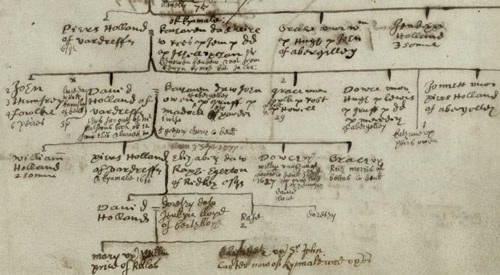 |
Extract of Har. MSS 1971 showing David Holland’s descendants. (click to expand) |
Piers ap David ap Piers ap John ap Dafydd ap Gruffudd ap Dafydd Holland, b circa 1560-70, d1643.
Piers was heir to David and succeeded to the Kinmel and Faerdref estates. He married Elizabeth fch Ralph Egerton of Ridley in Cheshire, the grandson of Sir Ralph Egerton who was prominent in the court of Henry V111. (see “Patronage at the court of Henry V111: The Case of Sir Ralph Egerton of Ridley”- archive.org).
 |
Egerton of Ridley Arms (see below for description) | ||
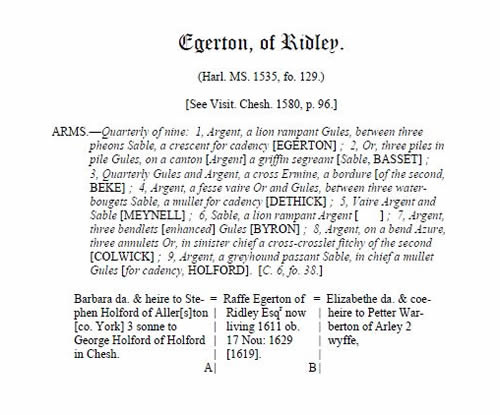 |
Visitations of Cheshire 1613 (The Record Society, Publication of Original Documents relating to Lancashire & Cheshire, Vol LV111, published 1909, p96) | ||
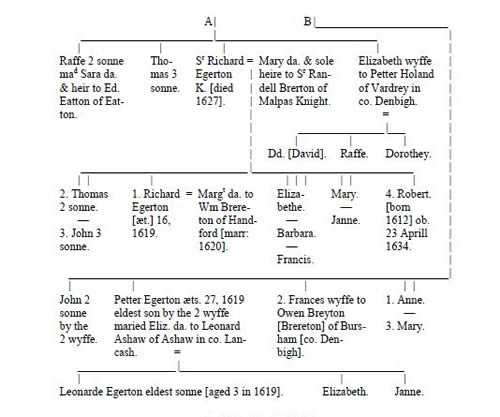 |
Visitations of Cheshire 1613 (The Record Society, Publication of Original Documents relating to Lancashire & Cheshire, Vol LV111, published 1909, p97) | ||
Piers and Elizabeth had three children:
David ap Piers ap David ap Piers ap John ap Dafydd ap Gruffudd ap Dafydd Holland, b circa 1590-1600, d before1633. (See below)
Ralph ap Piers ap David ap Piers ap John ap Dafydd ap Gruffudd ap Dafydd Holland, b circa 1590-1600. His existence is confirmed by the above visitation, and we know he was living in 1638 as evidenced in Piers’s will where he was named as executor.
Dorothy fch Piers ap David ap Piers ap John ap Dafydd ap Gruffudd ap Dafydd Holland, b circa 1590-1600. We know she was still living in 1638 from Piers’s will, however, there is no trace of her thereafter.
Surprisingly there are very few deeds containing references to Piers in the Kinmel and Coed Coch papers, and there is no evidence that he held any official positions in the county. The main deeds are those relating to the disbursement of the Kinmel estate which are covered in the notes on his son and heir David Holland below.
Piers wrote a will in 1638 which was probated in 1643 as (SA/1643/72W). He pre-deceased his heir David and therefore had the responsibility of deciding how the Kinmel estate should be entailed as David had no male heir:
“And whereas upon agreement made between me and Dorothia Holland, widow, my daughter in law I have inter alia for the special consideration of seven hundred pounds of lawful money to be paid in hand unto me ,assurd all myne estate of inheritance upon my grandchildren Mary Holland and Elizabeth Holland the daughters and heirs of David Holland deceased my eldest son and that also upon oped and willfull (breaths) of the said agreement there is a trust committed by me, and now depending between me and the said Dorothia and others by whom the trusts are not confessed, now discussed----“
“And should the said trust be discontinued by my death or that of my son Raiph Holland be deseated thereof, for the disposal thereof and expression of my intent concerning the same I do by this my last will give lease and bequeath the sum of six hundred pounds, part of the said sum of seven hundred pounds unto my said son Raiph Holland for his better preferment and advancement of his living. I do give and bequeath to my daughter Dorithia Holland the sum of one hundred pounds of like lawfull money”
According to the notes preceding the Kinmel MSS in the Bangor University Archives, Piers had not managed the estate very well. In 1933 he demised for the term of sixty years Faerdref and its demesne lands in St George, together with other lands in Bodtegwel, Boderyn, St George, Dinorben, Hendregyda, Gwrych, Abergele and Meifod to his widowed daughter in law Dorothy Holland and her three brothers Sir Edward Lloyd of Berthlwyd, James Lloyd of the Inner temple and John Lloyd of Jesus College, Oxford. In return they were to pay off his debts which amounted to £5000 (Approx (£500,000 in 2017 money) and provide him with an annual income of £60 per annum.
Elizabeth was buried in 1631, pre-deceasing Piers by 12 years (Cwytta, p139), Piers being away at Ludlow at the time.
David ap Piers ap David ap Piers ap John ap Dafydd ap Gruffudd ap Dafydd Holland, b circa 1590-1600, d before1633.
From the available MSS we can deduce that David died before 1633. He married Dorathy, b circa 1594, daughter of Jenkin Lloyd of Berllwyd near Llanidloes, (boydhouse.com) and his wife Dorothy, daughter of Edmund Walter of Ludlow, Dorothy fch Jenkin was one of twelve children. David and Dorathy had two daughters, Mary and Elizabeth. Mary married in 1641 so it is probable that David was in his twenties when he died.
Mary fch David ap Piers ap David ap Piers ap John ap Dafydd ap Gruffudd ap Dafydd Holland, b circa 1620,
In 1641 Mary the eldest daughter married Colonel William Price of Rhiwlas, Merionithshire. As a pre-nuptial agreement dated 2nd June 1641, Dorothy and her Brother James Lloyd, acting as guardian, agreed to settle on Mary and William the moiety of the capital messuages with the appurtenances together with all the rest of the estate, subject to certain specified limitations, including the provision of a jointure for Dorothy Holland and annuities for the surviving children of Piers Holland (Ralph & Dorothy). As for the 60 years’ lease granted by Piers to Sir Edward Lloyd in 1633, William Price was to have a seven-year renewable lease of the property concerned during the residue of the specified term.
William Price was a Colonel in the Royal Army during the Civil war. He was Member of Parliament for Merionithshire 1677-79 and, JP for Flintshire, 1680. He died in 1691 and is buried in St Asaph Cathedral. William and Mary had twelve children (Gfs, p247). William Price’s sister Jane was married to Mary’s cousin Thomas Holland of Teirdan.
Elizabeth fch David ap Piers ap David ap Piers ap John ap Dafydd ap Gruffudd ap Dafydd Holland, b circa 1620,
In 1647 Elizabeth married Sir John Carter, Knight, a colonel in the Parliamentary Army, i.e. directly opposed to her brother in law. John and Elizabeth had seven children. (Gfs, p 259).
The Online Biography of Wales describes Sir Jon Carter as follows:
He was born. at Dinton, Bucks, being the eldest son of a Thomas Carter; a younger son, William, became a wealthy London merchant. Tradition avers that John started life as a linen-draper — hence the contemporary pun which described his marriage as the acquisition of ‘the best piece of holland in the county.’ But in 1645 he was successively captain and colonel of horse at Brereton 's siege of Chester, and was one of the commissioners at its surrender in Feb. 1645/6. In close association with George Twiselton , he took an active part in the siege of Denbigh, and in the administration of the town after its capitulation in Oct. 1646. In Nov. Carter was made governor of Conway castle, and subsequently commander in North Wales. The Second Civil War ( 1648 ) saw him again co-operating with Twiselton in the defeat and capture of Sir John Owen ( 1600 - 1666 ) near Llandygái . In 1650 he was sheriff of Caernarvonshire and a commissioner under the Act for Propagation of the Gospel in Wales; in 1651 (confirmed by Cromwell in his governorship of Conway), and again in 1656, lord-lieutenant of Caernarvonshire. He was Member of Parliament for Denbighshire in 1654, 1656, and 1658-9; and Cromwell knighted him c. March 1657/8. But towards the end of the Protectorate, Carter was evidently ‘trimming’; he was expelled from the Rump Parliament. After the Restoration he was knighted afresh (June 1660) by the king, was, for a short time, Member of Parliament for Denbigh, was steward of the manor of Denbigh (July 1660), governor of Holyhead (Nov. 1660), and sheriff of Denbighshire in 1665. He died. 28 Nov. 1676 (being then ‘57’ — a very dubious statement), and was buried in the (now ruined) chancel of the old church of S. George (in Welsh, Cegidiog or Llansantsiôr). His character and trustworthiness have been variously estimated.
The Carter dynasty at Kinmel was but short-lived. Sir John 's son, THOMAS CARTER (d. 24 July 1702), was in chronic financial difficulties, and was in 1695 a prisoner in the Fleet. His two eldest sons, John and Thomas, had predeceased him in 1686, and it was his surviving son, WILLIAM CARTER, who inherited the heavily encumbered estate. In 1729 William procured an Act of Parliament, allowing him to sell out to Sir George Wynne of Leeswood, Flints.; William then went to live at Redbourn, in Lincs. The Kinmel estate continued to be an embarrassment even to its new owners, and in June 1781 a decree of Chancery sanctioned its sale to a David Roberts , of London , who, however (with his associates), sold it again, in 1786 , to the Rev. Edward Hughes — see the article Hughes , Hugh Robert , which brings the story of Kinmel down to 1911 . It may be added here that Hugh S. B. Hughes d. in 1918, and his brother and heir in 1940. The house (which had been rebuilt) was occupied by the War Department during the 1914-19 war, and was sold in 1934; but the greater part of the lands passed to the heir who, in 1953, deposited the family papers in the library of University College, Bangor.
These are the Kinmel MSS referred to above.
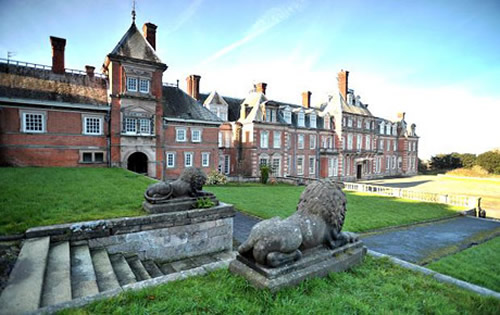 |
The marriages of David’s two daughters resulted in his large land holdings in and around Abergele going out of the Holland family, leaving the remaining estates of Teirdan, Hendre Fawr and Wickwer. A puzzle exists as to why Ralph, 2nd son of Piers, did not inherit the Kinmel estate to prevent it going out of the family.The most likely explanation is that the only way of settling Piers’s debts was to lease it to his daughter-in-law Dorothy and her brothers, on the understanding that it would eventually pass on to her daughters. | |
| Grade 1 listed Kinmel Hall built by Edward Hughes bears no resemblance to the Kinmel Old Hall built by David Holland in the 16th century. The property was to be offered for sale by auction on 12 October 2011 with a reserve price of £1.5million which did not include the 5,000 acres of surrounding land. However, it was bought shortly before auction by a businessman who bid closest to the £1.5m guide price. He intended to develop the property into a hotel, but these plans never materialised and the property lies derelict. | ||
Kinmel Hall was identified by the Victorian Society as one of the top ten at-risk Victorian and Edwardian buildings in 2015. |
||
Hendre Fawr
William ap Dafydd ap Gruffudd ap Dafydd, b circa 1500-10, d1588.
 |
Being the son of his father’s second marriage William was probably born circa 1500-1510. As evidenced by his will dated 1588 he lived to a good age. He married 1st Jane fch Meredydd Lloyd ap Hugh Conway Fychan (Vaughan) of Bryneuryn, whose aunt Elizabeth fch Hugh Conway Hen married William’s cousin Morgan Holland of Eglwys Fach. William and Jane had one known child, John. (See Guilsfield below) |
William married 2nd Katherine, daughter and co-heiress of Thomas Davies, ap Dafydd ap Robert of Nanhoran Issa and his wife Margaret Holland. Thomas Davies is thought to have been born in either Caerhun or Conwy circa 1511/12. In 1535 the rectory of Llanbedr Y Cennin and vicarage of Cerhun were conferred on him, and 1546 he was holding the post of Chancellor of Bangor Cathedral. Between 1535 and 1548 he studied at Oxford and Cambridge before being elected as Bishop of St Asaph in 1558, a position he held until his death in 1573. We know from William’s will (PROB 11/72/721) written in 1588 that he had three sons by his second wife Katherine: Piers, Thomas and Edward, and four daughters Elen, Alice, Jane and Dowce:
In the Name of God Amen the 3rd day of November in the year of our Lord God 1587 I William Holland of Abergele whole in body and good and perfect mind and memory do make and ordain this my last will and testament in manner and form following. First, I bequeath my soul unto almighty God my body to be buried in Christian burial. I bequeath unto the exporation of that church wherein it shall be buried five hoopes of wheat. Then I will, demise, give and bequeath unto John Holland my son and master of the arts all my lands, tenements and hereditaments which I bought of Richard Peake of Conwy called Y Weirglodd, Devio and Weirith Lynige and being in Penvro and Castell within in the Comote of Isaph within the county of Caernarfon, to have hold occupy and enjoy the same until my son Piers Holland or any in his name, interest or behalf do pay or to be paid unto my said son John Holland master of the arts, the sum of three hundred marks to be equally divided amongst my four daughters Helen Holland, Alice Holland, Jane Holland and Dowce Holland. And if any of them do not the counsel of my overseers but will withdraw herself from it. Then my will is that her part or parts of them that so do shall equally be divided amongst the rest which will do the same, I mean the counsel of my said overseers. Further my will is and I do give and bequeath unto Thomas Holland my son the same lands, rent and herditaments which I bought of Cadwaleder ap Pires ap Robert ap Hugh within the township of Castell within the county of Caernarfon and known by the name of Cau Tatnell (Arddulliro) (tiu) David ap Jonet ap Grittin to have hold occupy and enjoy to him and his heirs forever. And in default of lawful issue of his body I will and bequeath the same tenements, rent and (revercions ) unto Edward Holland another son of mine known or called by the name or names Cau Tatnell Gerw Llin (tiu) David ap Jonet ap Grittn with their appurtenances. Then my will is I do will and bequeath to the said Edward Holland the same tenements and lands houses and hereditaments which I bought and purchased of David ap John ap Robin in Abergele within the lordship and county of Denbigh to him and his heirs forever. Also I do make and ordain my well beloved sons John Holland, Thomas Holland and Edward Holland to be my sole executers of this my last will and testament And the said John Holland my nephews William (Cotemore) , Foulk Salisbury to be my overseers. I will bequeath to either of them a couple of (???????)(??????) my legacies fulfilled, my debts, my body to Christian burial this executed by me William Holland.
Thomas Davies made his will in 1570 (PROB 11/55/332), three years before he died, and in it he mentions three of Katherine’s sons, Piers, Thomas and Edward, There is no mention of any daughters of William in Thomas’s will, however, Thomas’s wife Margaret’s will, dated 1573 (PROB 11 /58/357) names three additional daughters of William and Katherine; Grace, Margaret and Katherine. None of the published pedigrees aknowledge all of these descendents. As there is no mention of Jane or Alice in Margaret’s will it is probable that they were born post 1573.
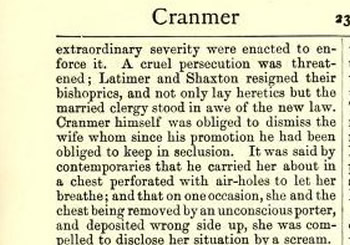 The number of children born to Katherine prior to 1573 poses a dilemma. Prior to the reformation in 1535 the clergy were not allowed to marry. Post the reformation in 1536 “The Ten Acts” were introduced which made no reference to marriage of the clergy and in some instances it was interperated by reformists that it was no longer forbidden. In 1532 Thomas Cranmer, prior to being made Archbishop, had married a German woman and secretly brought her home to England. Cranmer was instrumental in drawing up the Ten Acts and it is conceivable that he deliberately omitted the issue of marriage of the clergy as it was in his own interests to do so. By 1539 Henry V111 had decided that the Ten Acts were being too loosely interpreted and replaced them with “The Act of Abolishing Diversity of Opinions” otherwise known as “The Six Acts”, one of which reintroduced the ban on marriage of the clergy. This act stayed in force until after Henry’s death in 1547 when permission for priests to marry was formerly allowed. The extract above from the Dictionary of National Biography about Thomas Cranmer appears to confirm that a number of married clergy existed by 1539. The number of children born to Katherine prior to 1573 poses a dilemma. Prior to the reformation in 1535 the clergy were not allowed to marry. Post the reformation in 1536 “The Ten Acts” were introduced which made no reference to marriage of the clergy and in some instances it was interperated by reformists that it was no longer forbidden. In 1532 Thomas Cranmer, prior to being made Archbishop, had married a German woman and secretly brought her home to England. Cranmer was instrumental in drawing up the Ten Acts and it is conceivable that he deliberately omitted the issue of marriage of the clergy as it was in his own interests to do so. By 1539 Henry V111 had decided that the Ten Acts were being too loosely interpreted and replaced them with “The Act of Abolishing Diversity of Opinions” otherwise known as “The Six Acts”, one of which reintroduced the ban on marriage of the clergy. This act stayed in force until after Henry’s death in 1547 when permission for priests to marry was formerly allowed. The extract above from the Dictionary of National Biography about Thomas Cranmer appears to confirm that a number of married clergy existed by 1539. |
If Thomas had married immediately after the 1547 act, then Katherine could have been born in 1548. Assuming she married circa 1563, i.e. age 15, her first child Piers could not have been born before 1564, it seems inconceivable therefore that she could have had eight children by 1573. The more likely scenario is that either Thomas married in the window of opportunity between 1535 and 1539 and that Katherine was born during that period, or, he married before he took holy orders sometime before 1535. This may explain why he only had one child as it would have been dangerous to have any more children after 1539. In this case Katherine may have married circa 1535. This conclusion is endorsed by the fact that William and Katherine could not have been married later that circa 1550 as William’s great-grandson Roger was Sheriff of Denbighshire in 1634, and is thought to have been deceased by 1640. It seems likely therefore that Piers was born circa 1550.
Some sources attribute Thomas with another daughter, Margaret, but there is no reference to her in any of the wills, and the Dictionary of National Biography states that he only had one daughter.
In his will Thomas Davies leaves his estate to his wife Margaret and then entailed to William’s sons Piers, Thomas and Edward, and then in default to his own brothers:
“I give and bequeath my chief mesne places called Brummie Melynnon and barns, orchards, edifices and all lands, meadows, woods underwoods and pastures to the same belonging, left situate and lying in the townships of Llanbedr Y Cennin and Castell within the Comote of Issaph in the county of Caernarvon And all other my tenements, lands, meadows, woods and underwoods and pastures with the appurtenances, left lying and being in the said townships of Llanbedr Y Cennin and Castell and elsewhere within the county of Caernarfon, Denbigh, Flint and Monmouth----------thereof unto Margaret Davies my wife and her assigns for and during the term of her natural life, and after her decease to remain unto Katherine Davies now wife of William Holland of Abergele, Esq.to have and to hold to the rest of her natural life to Piers Holland, son of the said Katherine and William Holland----“
Also in Thomas’s will he bequests:
“ I bequeath unto ????? fch Hugh Holland my sister’s daughter the sum of seven pounds of money”
“ I give and bequeath to Margaret fch Dafydd ap Robert, my sister and her assigns one of the six parcels of the tithe of corn and hay---“
There is no Margaret ap Dafydd ap Robert on the Gfs pedigree (p162), the origin of her husband Hugh Holland is unknown. There are no unmarried Hugh Hollands on the Anglesey, Conwy, Eglwys Bach pedigrees that could have married Thomas Davies’ sister. The only unallocated Hugh Holland is Hugh ap Piers ap John of Faerdref who was vicar of Llanegryn in 1582 (see above). Although no wife is attributed to him on the Gfs pedigree (259) it is quite possible that he married after 1547.
In Margaret Davies’ will she identifies herself as “I Margaret Holland, otherwise called Margaret Davies, widow”. The Gfs pedigree (p162) does not name the wife of Thomas Davies, the origin of Margaret Holland has so far not been identified.
The children of William and Katherine are therefore as follows:
Piers ap William ap Dafydd ap Gruffudd ap Dafydd, b Circa1550. Heir to Hendre Fawr (See below).
Thomas ap William ap Dafydd ap Gruffudd ap Dafydd, b Circa 1551-1570. Other than that he was alive in 1588 we have no further information about him.
Edward ap William ap Dafydd ap Gruffudd ap Dafydd, b Circa 1553-1570. Other that he was alive in 1588 we have no further information about him.
Grace fch William ap Dafydd ap Gruffudd ap Dafydd, b Circa 1555-70. According to Gfs(p259) she married Ffoulk Myddleton of Archwedlog, Llansanan. It is not known if there was any issue.
Dowce fch William ap Dafydd ap Gruffudd ap Dafydd, b Circa 1557-73. Mentioned in both William and Margarets wills.
Ellyn (Helen) fch William ap Dafydd ap Gruffudd ap Dafydd, b Circa 1559-73. Mentioned in both William and Margarets wills.
Margaret fch William ap Dafydd ap Gruffudd ap Dafydd, b Circa 1561-73. Mentioned only in Margaret’s will.
Katherine fch William ap Dafydd ap Gruffudd ap Dafydd, b Circa 1563-73. Mentioned only in Margaret’s will.
Jane fch William ap Dafydd ap Gruffudd ap Dafydd, b after 1573. Mentioned only in William’s will.
Alice fch William ap Dafydd ap Gruffudd ap Dafydd, b after 1573. Mentioned only in William’s will.
There is no further information available about William’s daughters, presumably Ellyn, Alice, Jane and Dowce were unmarried in 1588. The others were perhaps married or deceased. With the absence of parish records there is no way to trace any descendants of William’s children other than Piers.
Piers ap William ap Dafydd ap Gruffudd ap Dafydd, b Circa1550.
David ap Piers ap William ap Dafydd ap Gruffudd ap Dafydd, b Circa 1570-75, d1611. Heir to Hendre Fawr (See below).
Catherine fch Piers ap William ap Dafydd ap Gruffudd ap Dafydd, b Circa 1570. Nothing is known of her other than the reference in the above pedigree.
John ap Piers ap William ap Dafydd ap Gruffudd ap Dafydd, b Circa 1570-75, d1651. There are no papers referring to him in the Kinmel or Coed Coch MSS. According to the above pedigree he married Anne Owen and this is confirmed by his will (PROB11/217) dated 1651, in which he describes himself as Minister of St George. Within a Memorandum relating to her will, dated 1667 (SA/1667/3), Anne “bequeathed unto Mr Ellis Owens, Clerk, Vicar of Llaneurion in Yale her brother twenty shillings as a surity in regards he may not trouble her nieces Anne and Catherine Hughes of Llanasaph, gent, for their surities hereafter named.” She also left all the residue of her estate, Goods and Chattels equally devided between these two nieces one generation removed, with nothing to any of the issue of the Holland families. In neither of their wills are there any references to children of their own, so presumably there was no issue from the marriage.
In John’s will there are bequests to a number of nieces and nephews, some of whom do not appear on any of the published pedigrees:
“Anne Holland my well beloved wife----my niece Katherine Parry wife of William Parry----Anne Holland younger daughter of Roger Holland my nephew, deceased---- my said cousin Ann Owen daughter of my brother-in-law Ellis Owen, clerk,---- my niece Elizabeth Mallory--- my nephews David Ffoulke, John Williams, David Vaughan and Piers Holland--- cousin Roger Wynne---- nieces Katherine Parry and Ann Holland and now in the hands and custody of Gabriel Parry, clerk”.
David (Daniel) ap Piers ap William ap Dafydd ap Gruffudd ap Dafydd, b Circa 1570-75, d1611.
There is no mention of him in any of the Coed Coch or Kinmel MSS. He married Elizabeth fch Morris Kyffin of Maenen by his 1st wife Margaret fch Thomas Mostyn of Mostyn. Morris Kyffin was HSC in 1579 and HSA in 1585. (Gfs p197). This Gfs pedigree refers to him as David not Daniel and gives his obituary as 1611. David and Elizabeth are attributed two children Roger and Luce on the Har. 1971 pedigree, whereas all other published pedigrees only name Roger. From the above pedigree of John Holland we can deduce that David probably had a son Piers, and three other daughters who had sons David Ffoulke, John Williams, David Vaughan.
Roger ap David ap Piers ap William ap Dafydd ap Gruffudd ap Dafydd, b Circa 1600, d1642. Heir to Hendre Fawr (See below).
Luce fch David ap Piers ap William ap Dafydd ap Gruffudd ap Dafydd, b Circa 1600-1610. She married Richard Mallory son of Thomas Mallory, Dean of Chester, who is buried in Chester cathedral. From John Holland’s will above we know that she had a daughter Elizabeth.
Piers ap David ap Piers ap William ap Dafyd ap Gruffudd ap Dafydd, b Circa 1600, d1642. We know of his existence from John Holland’s will. There are no other Piers Hollands living in 1651 on any of the other associated pedigrees that could be considered as a nephew of John Holland, hence it seems reasonable to assume he was a son of David. There are no other references to him.
Daughter 2 fch David ap Piers ap William ap Dafydd ap Gruffudd ap Dafydd, b Circa 1600-1610. Had a son David Ffoulke, so presumably married A N Other Ffoulk.
Daughter 3 fch David ap Piers ap William ap Dafydd ap Gruffudd ap Dafydd, b Circa 1600-1610. She had a son John Williams, so presumably married A N Other Williams.
Daughter 4 fch David ap Piers ap William ap Dafydd ap Gruffudd ap Dafydd, b Circa 1600-1610. She had a son David Vaughan, so presumably married A N Other Vaughan.
David died in 1611, his burial is recorded in Cwytta p28.
Roger ap David ap Piers ap William ap Dafydd ap Gruffudd ap Dafydd, b Circa 1600, d1642.
 |
Roger was born circa 1600. In 1628 he married Jane Parry (Cwytta.p125), daughter of Richard Parry of Pwll Halawg, Cwm, who became Bishop of St Asaph in 1604. He was the son of John ap Harri of Pwll Halawg being descended from Cynwrig Efell an illegitimate son of Madog ap Meredydd, Prince of Powys. Bishop Parry had married Gwen fch John ap Rhys Wynn of Llwyn Yn and Caer Ddineu in Llanfair Dyffryn Clwyd, descended from Edwin ap Goronwy, Prince of Tegeingl. (Powys Fadog Vol 5, p208-225 gives a full description of the Parry family and connections). | |
| Roger and Jane had three known children, Roger, Catherine and Anne. There exists conflicting assumptions regarding which Roger Holland was the father of Catherine and Anne. Some pedigrees assume that Roger ap Roger Holland died without issue, whilst others assume that Catherine and Anne were his daughters. Roger senior married Jane in 1628, therefore Roger junior would not have been born until 1629 at the earliest. As Catherine married William Parry of Llwyn Yn in 1643 it would have been mathematically impossible for her to have been the daughter of Roger junior. Cwytta Cyfarwydd, p 205, has the following entry: | ||
|
||
Sheriffs of Denbighshire Arch Camb 1869, p107/8 and 1870, p177)
“1634- Roger Holland of Hendre Fawr in the parish of Abergele, Esq., was the eldest son of Daniel Holland of Hendre Fawr, Esq., by Elizabeth his wife daughter of Morris Kyffin, Esq. By his wife, Jane Parry, he was father of Roger whose heiress Catherine married William Parry of Llwyn Yn, Esq. Abergele Church contains a monument erected to the memory of Catherine Parry. Roger Holland died in 1640.”
“1668- William Parry of Llwyn Yn, Esq., This gentleman married Catherine, daughter and heiress of Roger Holland of Hendre Fawr, the son of Roger Holland the high sheriff for 1634.Bishop Goodman speaks of Mr Parry, in his will as the heir of his sister Susan and bequeaths to my cousin William Parry of Llwyn Yn, and his sister five pounds. By his wife who died in 1706 Mr Parry had issue six sons and five daughters, whereof two survived her only, viz 1-David the sheriff of 1695 and2- Susannah, married to John Roberts of Hafod Y Bwch, sheriff in 1705”
The following is the inscription that existed in Abergele church at the time:
“Here lies the body of Catherine, Daughter and heir of Roger Holland of Henfdrefawr, in the county of Denbigh, and relict of William Parry of Llwyn Yn, in the foresaid county, Esq., by whom she had 6 sons and 5 daughters, whereof 2 survived her only. David Parry, late of Llwyn Yn, Esq., and Susannah, married John Roberts of Hafod y Bwch, in the county of Denbigh Esq. She was a person devout without affectation, serving God strictly according to Rules established among us. Frugal in management of her time, of which her Maker had always the first fruits. And those temporal blessings which he did plentifully pour upon her, often praying not for these, but for the grace to use them. Her conversation was plain without art, and prudent without jealousy. Her justice universal, but her charity discreet, seasonable, on due occasions, bountiful, and often secret. She lived to a good old age, much beloved and no less esteemed, and having discharged the relative duties of a Daughter, wife, and mother successively and faithfully, she has departed to a better life ??day of?? AD 1706” (Ancient and Modern Denbigh, p205, Arch Camb 1860, p112).
Roger senior was Sheriff of Denbigh in 1634 and Justice of the peace. He left a will dated 1642 (SA/1642/1) in which he seemed primarily concerned about the settling of his debts and the tuition and guardianship of his eldest daughter Catherine and his other daughter Anne which he entrusted to David Pennant and John Holland, presumably his uncle. He also mentions his wife Margaret as his sole executor. We know from Cwytta Cyfarwyd that his first wife Jane died in April 1641, so he wasted no time in remarrying, possibly intent on producing a male heir following the death of his only son Roger. Margaret was the daughter of Edward Wynn of (Usryn), relict of Robert Owen of Halkyn, descended from Owen Gwynedd. There was no issue from this marriage. His burial is recorded in the Nannerch parish records “Roger Holland, Armiger buried 25th Nov 1642”
Roger ap Roger ap David ap Piers ap William ap Dafydd ap Gruffudd ap Dafydd, b Circa 1629, d before 1641. Little is known of him, all the references to him being the father of Catherine and Anne are incorrect. He pre-deceased his father making heiresses out of his sisters.
Ann fch Roger ap David ap Piers ap William ap Dafydd ap Gruffudd ap Dafydd, b Circa 1630. She was Roger senior’s youngest daughter. She married Richard Parry of Coed Marchan (Powys Fadog Vol3, p51, Har. MS 2180).
Catherine fch Roger ap David ap Piers ap William ap Dafydd ap Gruffudd ap DAfydd, b Circa 1630, d1705.
Catherine was Roger senior’s eldest daughter and owing to the death of her brother, Roger junior, she became the heiress of Hendre Fawr on the decease of her father in 1642. In Roger’s will he settled his estate to David Pennant and John Holland for a period of ten years after his decease, with the proviso that if his eldest daughter should marry within the ten years the estate would pass to her. They were also named as guardians:
“Item, I do give and bequeath the tuition, guardianship and marriage of my said eldest daughter Katherine unto the said David Pennant and John Holland for the better enabling of them to pay my debts----“
At this time Catherine was a minor, being approximately 12 years old. In 1643, aged approximately 14, she married at Dissserth (Dyserth) William Parry of Llwyn Yn (Cwytta, p207), a descendant of Bishop Richard Parry’s brother John ap John ap Harri, which brought together the estates of Llwyn Yn and Hendrefawr. William Parry was the son of Gabriel Parry, who was headmaster of Ruthin school in 1607. Gabriel Parry, Clerk, was entrusted with the custody of forty pounds that John Holland had left in his will to his nieces Catherine Parry and Ann Holland. Gabriel Parry, Bachelor of Divinity, died in 1662 leaving his lands in Abergele and Lonyvydd and his English books to his son William.(Genealogical Abstracts of Parry Wills). The Will also included the following bequest:
“£100 due from me to my cousin Anne Parry on the death of Margaret, widow of John Holland, Esq. or of Elinor Price, widow,whichever shall die first”.
It is not clear who this John Holland is. John Holland, Clerk of Guilsfield died in 1639, but his wife Margaret died in 1649. John Holland of Teirdan had a wife Margaret but he died in 1682, i.e after Gabriel’s will. No other John Holland Esquires have been found on the associated pedigrees.
As can be seen from the above memorial in Abergele church William and Catherine had eleven children in total, however all but two pre-deceased her. In 1693 her daughter Susannah married John Roberts Esq., of Hafod Y Bwch and Plas Newydd. Catherine died in 1705 at the age of about 76 and was buried in St Michaels Church, Abergele. Catherine’s son David Parry was HSD in 1695 and 1697, he would have inherited the estates of Llwyn Yn and Hendre Fawr, however, he died without issue in 1706 and so the Hendre Fawr and Llwyn Yn estates passed to Susannah, she and her husband John Roberts therefore held the estates of Llwyn Yn, Hendre Fawr, Hafod Y Bwch and Plas Newydd. John Roberts was HSD in 1704, and MP for Denbigh 1710-15, he died in 1731 and was buried at Llanfair Dyffryn Clwyd, Susannah having pre-deceased him at Plas Newydd in 1721. They had no male heir and their daughter Catherine Roberts inherited their combined estates.
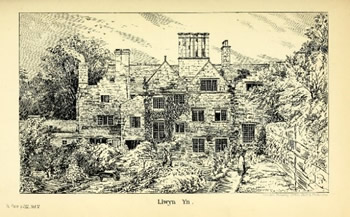 |
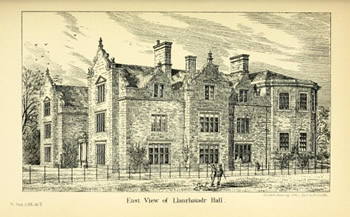 |
In 1714 She married her cousin Humphrey Parry, great-great-grandson of Bishop Parry, bringing together the estates of Pwll Hawlag, Plas Y Ddol, Llanrhaidr Hall, Croft Wyn and Meillwen via Humphrey and Llwyn Yn, Hafod Y Bwch, Plas Newydd and Hendre Fawr via Catherine. William and Catherine had 5 sons and eight daughters. Humphrey died in 1744 and Catherine in 1751 and the vast estate was divided amongst their descendants.
The pedigree below shows the descent of Parry of Pwll Hawlag, and Holland of Hendre Fawr, and the connections between the two families, and is an example of how vast estates could be accumulated through marriage due to lack of male heirs. The timeline confirms the assumption that Piers Holland of Hendre Fawr must have been born circa 1550 as suggested above, and therefore Bishop Thomas Davies must have married sometime around 1531-35.
The male line of Hendre Fawr ran out with the death of Roger Holland senior in 1642, shortly after the male line ran out at Kinmel and Faerdref with the death of David Holland circa 1630. This ended 200 years of domination of this large area of Denbighshire by the Holland family, leaving Teyrdan and Wickwer as the remaining estates.
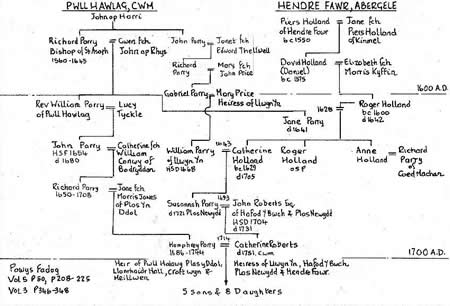 |
The pedigree shows the Holland and Parry family interactions from 1550 to 1700. | |
Guilsfield, Montgomeryshire.
John ap William ap Dafydd ap Gruffudd ap Dafydd, b circa 1550, d 1639.
He was the only known son of William by his 1st marriage to Jane fch Meredydd Lloyd. Theoretically he was William’s heir but presumably he opted not to inherit Hendre Fawr as he had taken Holy orders and was settled as Rector of St Aelhairarns church, Guilsfield (Cegidfa), Montomeryshire. He married Margaret Lloyd of Penporchell, Llanefydd by whom he had three daughters, Ellen, Jane and Elizabeth.
John made his will in 1634 (SA/1639/34) which was probated in 1639, in which he left to his eldest daughter Ellin, his second daughter Jane and his youngest daughter Elizabeth, twelve pence apiece. He left all the rest and residue of his goods, cattells, chatells and credits etc to his wife Margaret who he named as his executor.
Ellin fch John ap William ap Dafydd ap Gruffudd ap Dafydd, b circa 1590-94.
She was born before1594, but her birth does not appear in the Guilsfield parish registers, neither is there a marriage or death. We know from her mother Margaret’s will, dated 1643 and probated in 1649 (PROB/11/212), that Ellin was still alive and probably single. What became of her afterwards is unknown.
Jane fch John ap William ap Dafydd ap Gruffudd ap Dafydd, b1595
Elizabeth fch John ap William ap Dafydd ap Gruffudd ap Dafydd, b1598.
She was born in 1598 (Guilsfield PR). “ Elizabeth filia Johannes Holland, Clerk, was baptised”. We know from her mother Margaret’s will that she married Thomas Lloyd and by 1643 they had three daughters under the age of seventeen years, Ann, Margaret and Jane.
After the death of her husband in 1639, Margaret moved from Guilsfield to Mansilin in Denbighshire. There were a number of parish record entries at Guilsfield for Holland around this period, the first of which was the death of Humphredus Holland in 1607, however, there is no obvious connection between these and John Holland. It has so far been found impossible to identify the origin of this other family of Hollands
Wigfair (Wickwer), St Asaph (Llanelwy).
The ancient parish of St. Asaph consisted of 13 townships. From 1310, responsibility for the "cure of souls" in the parish was shared by the four Vicars-Choral of the Cathedral; and for this purpose, the townships were grouped as follows:
- Brynpolyn, Cyrchynan, Gwernglefryd.
- Bodelwyddan, Pengwern, Fanol.
- Meriadog, Wigfair (or Wickwer) - both in old Denbighshire.
- Bodeugan, Cilowen, Gwerneigron, Rhyllon, Talar.
On 3 August 1860, the townships of Bodelwyddan, Pengwern and Fanol were lost to the newly created parish of Bodelwyddan. In 1865, the townships of Meriadog and Wigfair were lost to the newly created parish of St. Mary's, Cefn (which is in old Denbighshire).
Luce (Lowry or Lleucu) ap Meredydd ap David Lloyd was the wife of John ap Piers Holland of Faerdref. At the time, Grace fch Piers Holland, John’s sister was living in Plas Newydd, Meriadog with her husband Foulk ap Robert who built the house in 1583. (See above under Faerdref).
John ap Piers ap John ap Dafydd ap Gruffudd ap Dafydd Holland, b circa 1520
As the above deed shows, the first of the Holland clan to reside in the township of Wigfair was John Holland son of Piers Holland of Faerdref. He married Luce (in some references, Lowry or Lleucu) fch Robert ap Meredydd of Wickwer.
The following deed describes the acquisition of a mansion house in Wigfair in 1599 which may have become the residence of John Holland, or possibly his heir William.
“Wigfair Estate Records: Bond for the quiet possession of the moiety of a mansion house wherein the said Hughe ap John ap William ...,
Is Part Of: Wigfair Estate Records Description: 1. Hugh ap John ap William of Wickwair Issalet, Edward Lloid of Galltvaynan, and Robert ap ... of Wickwair aforesaid, all of co. Denbigh, gentlemen; 2. Dauid Holland, esq. Bond for the quiet possession of the moiety of a mansion house wherein the said Hughe ap John ap William lately lived and the moiety of a barn and orchard in the township of Issalet, co. Denbighe, in accordance with the terms of a deed of mortgage.
Related Titles: Wigfair Estate Records, Creation Date: 1599, September 12.
According to the published pedigrees John is only attributed one son, William, who succeeded him to the Wigfair estate, however, from various wills and estate papers we can deduce that he had at least five sons. As William was not born until 1576 it seems likely that he was the youngest son and his brothers pre-deceased him.
William ap John ap Piers ap John ap Dafydd ap Gruffudd ap Dafydd Holland, b 1576, d1650. He became the heir to John (See below).
Thomas ap John ap Piers ap John ap Dafydd ap Gruffudd ap Dafydd Holland, b circa 1540, d1570, Gent. He is referred to as John Thomas Holland in some references and John in Cwytta Cyfarwydd. He married Janet fch Llewelyn ap Robert (Kinmel MSS 505) and we know from this MSS and his will (SA/1570/47/R) that he had a brother Piers, a son John Thomas, and five daughters, Margaret, Grace, Lowrie, Catherine and Elizabeth. It seems unlikely therefore that he married after 1560 and would therefore have been born circa 1540.
Kinmel MSS 505 June 4th 1606 1-John Thomas Holland of Llandulas, Gent., 2-John Wynn Holland and Hugh ap John ap Ieuan, Gent. SEETLEMENT (after the marriage of Foulk ap John Thomas Holland, and Gwen, his wife deceased) of messuages, lands and tenements in Meriadog, formerly belonging to Jonet fch Llewelyn ap Robert, mother of the said John Thomas Holland; to the use of the said Ffoulk and Gwen and their heirs, with remainder to Peter ap John Thomas Holland, another son of the said John Thomas Holland with the remainder to John ap John Thomas Holland, another son, with remainder to the right heirs of the said Foulk and Gwen”.
There is no record of what became of Thomas’s daughters.
John Thomas ap Thomas ap John ap Piers ap John ap Dafydd ap Gruffudd ap Dafydd Holland, b circa 1560, d1612. He was married to Jane (origin unknown). It can be deduced that they had three children Peter, Ffoulk and John Ffoulk. His death is recorded in Cwytta p34.
Peter ap John Thomas Holland b circa 1580-85- Of Peter there is no further information.
Ffoulk ap John Thomas Holland b circa 1580-85 - From the above MSS we know that he married Gwen who was deceased by 1606, therefore it is unlikely that there was any issue. Ffoulk died in 1615 (Cwytta p 56).
John Ffoulk Holland ap John Thomas Holland, b circa 1580-90- In 1633 he married Anne fch Piers Roberts, the author of Cwytta Cyfarwydd (Cwytta p149) and his wife Jane fch Dafydd ap Lewes who he married in 1606. They were clandestinely married in the house of William ap Hugh, shoemaker in Denbigh and nine days later they were lawfully married in their own parish church in St Asaph. Within Cwytta he is repeatedly referred to as Ffoulk ap John Thomas or John Ffoulk, having apparently dropped the name Holland. They had three children, Alice b 1634, d1638; William Ffoulk Holland b1636, and an unnamed stillborn child in 1646 resulting in the death of his wife Anne “who was buried on the south side of the burying place of Bronwhwylfa wherein her mother was buried”. William was born “in the old house in Meriadog (the new house being newly thatched and ready to be inhabited)”. (Cwytta p157,164,176,181,221, also Bronwhylfa pedigree p(xv111). There is no trace of William thereafter.
Katherine Ffoulk fch John Thomas Holland b circa 1580-90, d1626. Her burial is recorded in Cwytta,pp 114: “Upon Wednesday being the xiith day of July 1626 one Katherine Ffoulk ap (fch) John Thomas Holland, spinster, was buried in the parish church of St Asaph”.
Piers ap John ap Piers ap John ap Dafydd ap Gruffudd ap Dafydd Holland, b circa 1540. We know from the will of his brother Thomas that he was alive in 1579, there is no trace of him thereafter.
Ffoulk ap John ap Piers ap John ap Dafydd ap Gruffudd ap Dafydd Holland, b circa 1540. As there is no mention of him in Thomas ap John’s will perhaps he was deceased by 1570.
John David ap John ap Piers ap John ap Dafydd ap Gruffudd ap Dafydd Holland, b circa 1540, d before 1608. His existence is confirmed within the deeds relating to his son John Wyn David Holland below. There is no reference to a spouse; from the Plas Yn Cefn paper below he was deceased by sometime between 1603 and1608.
John Wyn David, Gent. ap John ap Piers ap John ap Dafydd ap Gruffudd ap Dafydd Holland, b circa 1570. He is the 2nd party in the above Kinmel MSS 505, where he is named John Wyn Holland, possibly to identify himself from his cousin John Thomas Holland. In 1602 John Wyn Holland of Abergele was a party in the grant of a messuage and a parcel of lands in Tynhengroen, Istulas to Foulke Vaughan (Nanhoran MSS Dec 15 1603). The following Plas Yn Cefn deed identifies his wife as Katherine fch Ithell:
1. Katherin verch Ithell widow, late wife of John ap Ieuan ap Ithell and afterwards wife of John Wyn Wyn ap John David Holland, gent. deceased; 2. Edward Jones of Tincadvell, gent. Release of a messuage, an orchard and five parcels of land called y Cae bach, y graig vaur, Llawr y neyodd, y Coyd ucha and y Cae newydd in Meriadog, co. Denbigh. Related Titles: Plas-yn-Cefn Papers and Documents, Creation Date: 1608, July 1.
William ap John ap Piers ap John ap Dafydd ap Gruffudd ap Dafydd Holland, b 1576, d1650, Gent.
William married Jane fch Edward Wynn of Picton. The following Wigfair and Plas Yn Cefn deeds dated 1608 refers to his mother and grandfather:
1. William Holland of Wickwer, co. Denbigh, gent.;. 2. John ap Robert Lewes. Confirmation of a grant in fee farm dated 11 June 1560, whereby Robert ap M'edd ap Dauid Lloid, gent., grandfather of the first party, and Luce verch Robert ap M'edd, mother of the first party, had granted to Robert ap Lewes ap Robert, since deceased, father of the second party, a parcel of ground called y Werne in Wickwer aforesaid.
Related Titles: Wigfair Estate Records, Creation Date: 1608, May 4.1. William Holland of Wickwer, co. Denbighe, gent.;. 2. David Holland of Vairdre, co. Denbighe, esq., and John Edwardes of Waeynwen co. Flint, gent.;. 3. Evan lloid of Wickwer aforesaid, gent. Covenant to levy a fine and a declaration of the uses thereof. Property mentioned - a messuage called tythyn kay Gwayn and closes in Wickwer, co. Denbighe, called kay Gwayn vawr, kay gwayn Vychan, kay Gronow grach, yr acre Bant and y Dryll yn y Merllyn,, a toft, tenement, orchard and lands in Wickwer late in the possession of Allice verch John lloid, widow, deceased, grandmother of the said William Holland, a messuage, tenement and lands in Wickwer late in the possession of Rees David ap llewelyn, and parcels in the same place called y ddol wen, y ddol dan yskybor, PLas Gronow, Dol ronow, y Vron wydd, y Vron ganol, y Vron issa, y Mydarth Mawr, y Mydarth Bychan, y Mydarth issa and llwyn Tuddyr.
Related Titles: Plas Yn Cefn Papers and Documents, Creation Date: 1608, June 14.
As William became heir to the Wigfair estate he presumably outlived his brothers. According to the pedigree in Powys Fadog he was coroner for Denbighshire. He had Ty yn Y Pwll, Camre and other lands adjacent to Fynnon Fair (St Mary’s Well) in the township of Wickwer. He married Jane d/o Edward Wynne and his wife Jane fch Piers Puleston of Anglesey. There are several deeds in the Wigfair, Plas Yn Cefn and Kinmel referring to land transactions by William.
William and Jane had seven children as follows:
David ap William ap John ap Piers ap John ap Dafydd ap Gruffudd ap Dafydd Holland, b 1603, d c1670, Esq. (See below).
Anne fch William ap John ap Piers ap John ap Dafydd ap Gruffudd ap Dafydd Holland, b1609. Her birth is recorded in Cwytta p13: “Upon Thursday the xv11th day of August 1609 Anne Holland one of the youngest daughters of William Holland of Wickwer (begotten of his body by the body of Jane Wen his wife) was christened ----“In 1640 she married William Davies (Cwytta, p193), there are no known issue.
Ffoulke ap William ap John ap Piers ap John ap Dafydd ap Gruffudd ap Dafydd Holland, b circa 1605, d1620. His burial is recorded in the Llanelwy PR and Cwytta p83: “Upon Sunday being the xiith day of November1620 FFoulk Holland (second son of William Holland, Gent.) was buried”.
Piers ap William ap John ap Piers ap John ap Dafydd ap Gruffudd ap Dafydd Holland, b1610. His birth is recorded in 1610 in the LLanelwy PR and Cwytta p 21 “Upon the xxiith of Febr’r 1610 Piers Holland one of the younger sons of of William Holland was christened”. There is no record od him thereafter.
Grace fch William ap John ap Piers ap John ap Dafydd ap Gruffudd ap Dafydd Holland, b1613. Her birth is recorded in Cwytta p 40: “Upon Monday, being the xx1xth day of March1613 one Grace (the daughter of William Holland, Gent) was born and christened”. There is no trace of her thereafter.
Margaret fch William ap John ap Piers ap John ap Dafydd ap Gruffudd ap Dafydd Holland, b1621. Her birth is recorded in Cwytta p 86: “Margaret Holland (one of the daughters of William Holland) was born and christened upon Saturday the xxiith of July). There is no trace of her thereafter.
Frances fch William ap John ap Piers ap John ap Dafydd ap Gruffudd ap Dafydd Holland, b1623. Her birth is recorded in the Holt PR’s, there is no further trace of her.
William died in 1650 (Llanelwy PR and Cwytta, p243) “Upon Wednesday in Whitsun week, being the vth day of June 1650, William Holland Gent. (aged 73 and going on 74 since May before) was buried” Jane died in 1651(Llanelwy PR)
David ap William ap John ap Piers ap John ap Dafydd ap Gruffudd ap Dafydd Holland, b 1603, d c1670, Esq.
There are several deeds within the Wigfair and Plas Yn Cefn papers referring to David ap William. His birth is given as 1603 (Llanelwy PR). In 1624 he married Marie Price fch Rees Owen of Plas Yn Cefn, Meriadog (Cwytta p103); they had three sons and two daughters as follows:
Robert ap David ap William ap John ap Piers ap John ap Dafydd ap Gruffudd ap Dafydd Holland, b1632, d1687 Gent. Heir to David (see below).
Grace fch David ap William ap John ap Piers ap John ap Dafydd ap Gruffudd ap Dafydd Holland, b circa 1630. In 1663 she married John Davies, Gent., a Yeoman (Wigfair MSS, 1663). The following refers to a land transaction between John Davies and Grace and Thomas Holland of Teyrdan involving lands in Wickwer.
1. William Holland of Wickwer, co. Denbigh, gent, and David Holland, gent. son and heir apparent of the said William; 2. Rees Owen of Meriadock, co. Denbigh, gent. Settlement (post nuptial) on the marriage of the said David Holland and Marie, daughter of the said Rees Owen, referring to a capital messuage in Wickwer, parcels in Wickwer called yr ardd hir, Cayer gwyr, yr Henblas, y weirglodd vawr, y weirglodd vechan, y cay Coch, Cae lleickie, maes y gwyddel, yr acker bant, y gerddi, y Caybwll, Cae Mierie Cochion, y Cae yn y glascoed and acker veilir, two other messuages and closes called y ddol wen, y ddol dan yskybor, dol Ronow, y vron wydd, y vron ganol, y vron issa, y mydarth Mawr, y mydarth Bychan, y mydarth issa, and llwyn Tudder in Wickwer aforesaid, and a toft or tenement in Wickwer called Tythin yr Hendy.
Related Titles: PLas Yn Cefn Papers and Documents, Creation Date: 1624/5, Jan. 31.There is no known issue from this marriage.
Mary fch David ap William ap John ap Piers ap John ap Dafydd ap Gruffudd ap Dafydd Holland, b1628, d1628. Her birth and death are recorded in the Llanelwy PR and Cwytta, p125; “Upon Saturday being the last day of January 1628 one Marie Holland (first and eldest daughter of David Holland begotten upon the body of Marie his wife) was buried, being christened the Thursday before”
William ap David ap William ap John ap Piers ap John ap Dafydd ap Gruffudd ap Dafydd Holland, b1630. His birth is recorded in Cwytta p131: “Upon Sunday being the xxth day of June 1630, William Holland the younger (son of David Holland, son and heir of William Holland of Wickwer the elder) was christened being born upon the Friday before.” As he did not succeed to the estate we assume he pre-deceased his brother Robert.
Thomas ap David ap William ap John ap Piers ap John ap Dafydd ap Gruffudd ap Dafydd Holland, b1644, d1681, Gent. Thomas was born in 1644, Llanelwy PR and Cwytta, p213; “1644, 4th day of August, Thomas Holland (third son of David Holland and Mary his wife) was christened” (Cwytta p213). There is no evidence that he ever married or had children. He was buried in 1681 at St Asaph (PR).
David died in 1670, his sons Thomas Holland, Yeoman, and Robert Holland, Gent. were named as his administrators (SA/1670/274).
Robert ap David ap William ap John ap Piers ap John ap Dafydd ap Gruffudd ap Dafydd Holland, b1632, d1687 Gent.
Robert was born in 1632 (Cwytta p143) and succeeded to the Wickwer estates. He married Ann Roberts as evidenced by his administration bond (SA/1688/) and they had four children. There are several references to his involvement in land transactions in the Plas Yn Cefn and Wigfair MSS. The descent below him primarily comes from the Gfs pedigree p259 as follows;
Roger ap Robert ap David ap William ap John ap Piers ap John ap Dafydd ap Gruffudd ap Dafydd Holland, b circa 1670, d1688, Gent. There is no evidence that he ever married; due to lack of a male heir the estate went out of the family via his sisters Mary and Jane. The latest known reference to him occurs in the following deed dated 1710;
1. Robert Ffoulkes of Pengwerne, co. Fflint, gent., son and heir of Peter Ffoulkes, late of Meriadog, co. Denbigh, gent., deceased, and Jane Roberts of Dynorben, co. Denbigh, widow, relict and administratrix of the goods of the said Peter Ffoulkes; 2. Roger Holland of Wickwer, co. Denbigh, gent., son and heir of Robert Holland., late of Wickwer, gent., deceased. Feoffment of a parcel of land called Bryn y Cay Coch in Wickwer.
Related Titles: Wigfair Estate Records, Creation Date: 1710/11, February 13.William ap Robert ap David ap William ap John ap Piers ap John ap Dafydd ap Gruffudd ap Dafydd Holland, b 1687, d1716. Gfs quotes him as being of Cyrchynan, one of the townships of St Asaph. He was born in 1687 and his burial is recorded in 1716 (Llanelwy PR). There is no record of a marriage although he appears to have had a son Edward, who was baptised 2 May 1715 and buried 6 days later. He had a second son also named Edward who was baptised 20th May 1716, two months before William’s death on July 26th. Edward was buried on the 26th May 1746 aged thirty, there is no evidence that he married. What happened to the Wigfair estate is unclear. William and Roger may have died at approximately the same time when Edward, the potential heir, was a minor, in which case Edward may have been the ward of one of his sisters. On Edward’s decease the estate would then have either been distributed between the sisters, or passed to the elder sister.
Mary fch Robert ap David ap William ap John ap Piers ap John ap Dafydd ap Gruffudd ap Dafydd Holland, b1678, d1729. Mary was born in 1678 (St Asaph PR). She married John Humphreys of Bodelwyddan Bach and afterwards of Tyddyn Issa in the township of Pengwern, St Asaph. He died in 1727, his administrator was his widow Mary Holland (SA/1727/199), Mary died in 1729 (Gfs). The St Asaph PR entry “Mary Holland of Vaynol buried Jan 26th, 1729 probably refers to her. Her administration Bond (SA/1728/258) names Anna Jones, her eldest daughter, and Hugh Pierce of Wickwer, her brother-in-law, and Hugh Parry of Bodelwyddan, as her administrators. According to Gfs p259 her daughter Ann married John Parry of Plasau in the township of Cwm who died in 1753. This implies that Ann adopted the surname Jones in preference to Parry. The fact that Ann is referred to as her eldest daughter, implies that she had at least one other daughter and no sons at the time of her death. Ann and John had four sons Thomas, John, William and Edward, and two daughters Mary and Susannah. Susanna, b1746, d1832. In 1763 Susannah married her cousin Hugh Pierce, b1737, d1788, the grandson of her sister Jane, and their son John Pierce married Sarah Hughes fch Richard Hughes of Trecastell and hence the Pierce family of Cefn Meriadog.
Jane fch Robert ap David ap William ap John ap Piers ap John ap Dafydd ap Gruffudd ap Dafydd Holland, b1682, d1749. Jane was born in 1682 (Llanelwy PR), she married Hugh Pierce in 1706, and she died in 1749 (Llanelwy PR). According to Gfs p259 they had a daughter Elizabeth b 1708, d1762 and in 1729 she married John Pierce ap Thomas ap Thomas of Nant Patrig in the township of Trefnant. They in turn had a son Hugh who married his cousin Susannah as mentioned above. Gfs states that Hugh Pierce the elder died in 1762 based on the the evidence of his will, however Hugh Pierce, Yeoman, of Meriadog who died in 1762 names his wife as Catherine. He also names his son William Hughes of Henllan, Mary Hughes wife of Paul Barnes, Robert Hughes of Vaynol, grandson, son of the said Robert Hughes, and his daughter Elizabeth Hughes. For some reason, he chose to change the surnames of his children to Hughes whilst retaining the name Price for himself. It is possible, but not certain that this is the same Hugh Price who married Jane Holland, as she pre-deceased him by 18 years it is possible that he remarried.
As parish records in the 17th century are not complete it is possible that there are some male descendants of the Wickwer families that have not been traced.
Teyrdan (Teirdan), Llanelion Yn Rhos.
Teyrdan Hall is a Grade 2 listed building which dates back to the 16th century and was probably built by Humphrey Holland, one of the sons of Piers ap John ap Dafydd Holland of Faerdref. Humphrey Holland married Agnes fch Rhys ap Dafydd, heiress of Teyrdan and there may have been an older property on the land. It is postulated that Teyrdan is a corruption of Ty Dan, meaning the house below the Church which aptly describes its location.
At the back of the house there is a track which leads to the Coed Coch estate, which took possession of the house by marriage after the Holland male line expired. Over the door at the back of the house is a Latin inscription “Delicias habet omne suas. Et gandia tectum". All the house has its delights and joys.
Nine generations of the Holland family occupied the house over a period of 250 years.
There is a brief description of the house in “The Heart of Northern Wales vol 2, p319” and on britishlistedbuildings.co.uk.
Humphrey ap Piers ap John ap Dafydd ap Gruffudd ap Dafydd Holland, b circa 1527-30, d1612, Gent.
 |
In the Kinmel MSS 222 and 223, dated 1598 there is reference to Humphrey Holland being of Towunan (Towyn) however the following Coed Coch MSS dated 1612, the year of his death, refers to an agreement in 1579 to a petition of part of the land in Teyrdan. From this we can deduce that Humphrey was already in possession of the Teyrdan estate by this date via his marriage to Agnes. | |
Memorandum that "Peter Holland of Kynmill, alias Kilmaill, father to David and Humphrey Holland granted a Deed of partition of part of Teyrdan to Humphrey Holland in 1579, The land was chiefly in Bettws Llaethfaen and Twnan Maessegwyd and Kilkin. He was buried in Llanelian in 1612." English. Paper. Related Titles: Coed Coch and Trovarth Estate Records, Creation Date: [?1612]. The following Coed Coch MSS suggests that he married Agnes in 1576: Coed Coch and Trovarth Estate Records: Deed whereby Peter Holland and David Holland his son and heir, in consideration of the marriage between Humphrey Holland and ..., “Description: Deed whereby Peter Holland and David Holland his son and heir, in consideration of the marriage between Humphrey Holland and Agnes verch Res, grant to the said Humphrey certain messuages, lands, tenements, etc., in the towns of Maysegwick, Kylken, Llaythvayn, Bodleuuyn and Towunan, in the parish of Bettus and Llanelian, in the comotes Of Istulas and Vghdulas in the Lordship and County of Denbigh. Signed by David Hollandd. Seal, initials R. S. Witnesses: John ap Gruff Vaughan, Mores ap John, etc. Vellum. Latin. Related Titles: Coed Coch and Trovarth Estate Records, Creation Date: 1576, August 10”. |
||
The main sources of the genealogy of the Teyrdan line comes from the pedigrees in Harly 1971, Gfs p102, Powys Fadog vol 5 p402-3 and Cwytta p xxv111, supplemented by the Kinmel and Coed MSS, tombstone inscriptions from Llanelian Yn Rhos parish church, together with parish record entries from Llanelian and neighbouring parishes. Humphrey married Agnes, daughter and heiress of Rhys ap Dafydd ap Howel of Teyrdan. They are attributed three children in the published pedigrees:
John ap Humphrey ap Piers ap John ap Dafydd ap Gruffudd ap Dafydd Holland, b circa 1575-80, d1654. (He was heir to Teyrdan see below).
David ap Humphrey ap Piers ap John ap Dafydd ap Gruffudd ap Dafydd Holland, b circa 1575-80, d 1613. From the Llanelian PR we know that he had a son William, b1610, but there is no reference to a spouse. David died in 1613 and was buried at Abergele on the 16th June. (Cwytta p45). There are no Abergele PR’s before 1647.
William ap David ap Humphrey ap Piers ap John ap Dafydd ap Gruffudd ap Dafydd Holland, b 1610. He was born in 1610 (Llanelian PR). There is no record of what happened to him thereafter. Recording of BM&D’s was patchy during the Commonwealth period,1649-60.
Lowry fch Humphrey ap Piers ap John ap Dafydd ap Gruffudd ap Dafydd Holland, b circa 1610-15. There is no further reference to her on record.
|
Humphrey died in 1612, although there is no PR entry or mention in Cwytta of this event. The adjacent tomb which lies in the churchyard of St Elian’s church, Llanelian, was erected in the memory of Humphrey Holland, and records the date of his death as 1612. The tomb is grade 2 listed and is described in The Heart of Northern Wales Vol 1, p348, however, there appears to be no obvious attempt at preservation. The side walls are adorned with heraldic shields, the inscriptions are on the top slab and are difficult to read due to a combination erosion and lichen incrustations. In addition to Humphrey, his son Thomas and grandson John are also entombed. It is not certain that the tomb dates back to 1612, it is more likely that it was added retrospectively by one of his descendants. A description of the heraldic shields is given in the chapter on heraldry. There is no record of the death of his wife Agnes. |
John ap Humphrey ap Piers ap John ap Dafydd ap Gruffudd ap Dafydd Holland, b circa 1575-80, d 1654.
Gent John was born circa 1575-80. He married Dulcibella (Dowse) Whyte, daughter of Roland Whyte of St Catherine’s Abbey, Llanfaes, near Beaumaris, Anglesey. (For the pedigree of Whyte of Friars, Llanfaes see Gfs p130). The friary at Llanfaes was demolished after the reformation of Henry V111 and Roland Whyte built a house there in 1623 called Friars. The friary was replaced by St Catherine's Church which still stands. John’s death is recorded in the St Asaph PR in 1654 “John Holland, Armiger sepulti 9th April”, and also in the Llanelian PR’s. He is only attributed with one child his son and heir Humphrey.
Humphrey ap John ap Humphrey ap Piers ap John ap Dafydd ap Gruffudd ap Dafydd Holland, b circa 1600-10, d 1634.
There is no record of Humphrey’s birth, however it is likely to have been between 1600 and 1610. His marriage is recorded in Cwytta p133: “—being the V11th day of December aforesaid 1630, one Humfrey Holland (son and heir of John Holland, Gent,) and Jane Humfreys v’t daughter of Thomas Humfreys esq’re, were married at Bodelwyddan by Mr Maurice Jones, vicar choral etc by force of a licence---“
Between 1630 and 1634, the year of his death, Humphrey had two sons, John born 1632 and Thomas born 1633. Humphrey pre-deceased his father by 20 years, his burial is recorded in Cwytta p 153: “—upon Thursday being the XXV1th of June 1634, Humfrey Holland Gent. Son and heir apparent of of John Holland Gent. Was buried at St George”. This left both his sons as minors, and presumably under the wardship of either their mother Jane and/or their grandfather John. There is a burial record for Jane Holland in the Denbigh PR’ 1654 which may have been Humphrey’s widow, this is also registered in the Llanelian PR. 1653.
John ap Humphrey ap John ap Humphrey ap Piers ap John ap Dafydd ap Gruffudd ap Dafydd Holland, b1632, d1644. John was born in 1632 and died in 1644 (Cwytta p142 & 212): “ --26th July 1632 John Holland Fil’ et heres of Humfri Holland nat’ ap’d Bodelwyddan baptizat fuit apud Kegidock ut Reg’rar’.”-“—upon Wednesday being the 30th day of April 1644, John Holland, son and heire of Humfrey Holland deceased, son and heir of John Holland of Tairdarne now living, was buried”.
There is no entry for John’s birth or burial in either the Llanelian or St Asaph PR’s, unlike his brother Thomas whose birth and burial are both registered at Llanelian. This highlights the unreliability of parish records during this period. There are only two births and no burials registered in the Llanelian PR’s between 1610 and 1653.
Thomas ap Humphrey ap John ap Humphrey ap Piers ap John ap Dafydd ap Gruffudd ap Dafydd Holland, b1633, d1683 Esq. Thomas was born in 1633 (Llanelian PR). In 1654 he married Jane fch John Price of Rhiwlas (Nannerch PR), she being the sister of William Price who married Mary Holland daughter and co-heiress of David Holland of Kinmel. Jane’s birth is recorded in Cwytta p 95 “–on Tuesday being the xxxvii day of July 1623 Jane daughter of John Price Esq. son and heir of John Price the elder, Esq. son and heir of Cadwalader Price late of Rhiwlas deceased was Christened, being born 5 or 6 days before”
Thomas was High Sheriff for Denbighshure in 1680 as evidenced by the following extract from Arch Camb 1870).
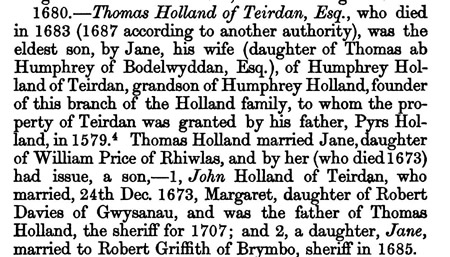 |
The published pedigrees attribute Thomas and Jane with only one child, John, but we can establish from his will, various PR’s, Cwytta Cyfarwydd and the above extract, that he had at least five other children, Humphrey, Elizabeth, Thomas, Jane and Margaret.
John ap Thomas ap Humphrey ap John ap Humphrey ap Piers ap John ap Dafydd ap Gruffudd ap Dafydd Holland, b1656, d1682. (Heir of Teirdan, see below).
Humphrey ap Thomas ap Humphrey ap John ap Humphrey ap Piers ap John ap Dafydd ap Gruffudd ap Dafydd Holland, b 1658. He was born in 1658 (Llanelian PR). There is no record of a burial and no further trace of him. He is not mentioned in Thomas’s will and it is probable that he died before 1683.
Elizabeth ap Thomas ap Humphrey ap John ap Humphrey ap Piers ap John ap Dafydd ap Gruffudd ap Dafydd Holland, b1661. She was born in 1661 (Llanelian PR). She received bequests in Thomas’s will when she appeared not to be married, there is no record of her thereafter.
Thomas ap Thomas ap Humphrey ap John ap Humphrey ap Piers ap John ap Dafydd ap Gruffudd ap Dafydd Holland, b1664, d 1696. He was born in 1664 (Llanelian PR). In 1689 he married Catherine Hookes of Conwy (Conwy PR) and they had two daughters Jane b 1691(Llanelian PR) and Margaret. In his farther’s will, in addition to monetary bequests, he received “all and singular my messuages lands and hereditaments in Llanelian, Llaethfaen, Twynan and Dolwen excepted such lands and hereditaments as are before mentioned by the said deed---“. The excluded lands are those in an indenture relating to Margaret Davies the wife of his recently deceased son and heir John Holland.
There are two administration bonds in which Catherine Holland is the administrator for a Thomas Holland. The first of these is dated 1696 (SA/1696/3) in which Catherine Holland of Abergele, widow, was the administrix of the goods, cattels and credits of Thomas Holland of the parish of Abergele, Gentleman. It seems likely that this was Thomas ap Thomas and may explain why there were no further children registered. The second, dated 1705 (SA/1705/27), appears to be the final administration of his father Thomas ap Humphrey. It appears from the attachments to SA/1683/82 that there was a dispute regarding the legality of the codicil written on the day of his death which changed some of the bequests. The inference was that he was not fit in body or mind when he devised the codicil, and the literacy of the witnesses was also in question. In the 1705 bond Thomas ap Thomas Junior, deceased was described as the sole executor of the will of Thomas Holland the Elder, however, in his original will Thomas senior did not name a sole executor, preferring to name six overseers. At the time, Thomas junior was aged 19 and therefore ineligible to be the sole executor, in the intervening period between 1682 and 1696 he must have assumed this responsibility after becoming of age. After his death in 1696 his wife Catherine took the responsibility being named in the 1705 bond as Catherine Holland of Llansanfraid in the county of Denbigh, widow:
“The condition of this obligation is that the above bounden Catherine Holland, lawfull administrix which the will and codicil annexed the goods, rights and credits, of Thomas Holland the elder late of Teirdan in the parish of Llanelian and diocese of St Asaph Esq., deceased, administered by Thomas Holland Junior next and lawfull son and sole executor the said Thomas Holland senior, deceased, do make and cause to be made the true and perfect inventory of all and singular the goods, chattels and credits of the deceased---- ”.
Jane fch Thomas ap Thomas ap Humphrey ap John ap Humphrey ap Piers ap John ap Dafydd ap Gruffudd ap Dafydd Holland, b1691. She was born in 1691(Llanelian PR).
Margaret fch Thomas ap Thomas ap Humphrey ap John ap Humphrey ap Piers ap John ap Dafydd ap Gruffudd ap Dafydd Holland, b circa 1692-5. There are no PR entries for Margaret but her existence is confirmed by the following Coed Coch MSS 2086 and 2109:
Deed whereby Catherine Holland, late of Place Issa in the Parish of Llansaintfraid, co. Denbigh, widow, and Jane Holland and Margaret Holland, daughters and heiresses of Thomas Holland, late of Boddegwal, deceased, sell for £80 to Thomas Holland of Teyrdan, co. Denbigh, a messuage and tenement with lands appurtenant, called Brin y neiodd in the said Parish. Signed and sealed by the vendors. Witnesses: Edward Lloyd, John Reignalds, Hugh Kyffin. English. Paper.
Related Titles: Coed Coch and Trovarth Estate Records, Creation Date: 1710, March 31.
Lease by Jane Holland of Conway, co. Caernarvon, and Margaret Holland of Mochtre, co. Denb., daughters and coheirs of Thomas Holland of Botegwal, co. Denb., gentleman, deceased, and Catherine Holland, widow, relict of the said Thomas, to Thomas Holland of Teyrdan, same co., esq., for 5s. of a messuage, tenements, lands, and appurtenances called Bryn y Neiodd, with named parcels of land thereto belonging, for one year at a peppercorn rent, with a view to making a grant of the same. Signed and sealed by the lessors. Witnesses: Margaret Holland John Holland, Edward Lloyd. English. Vellum.
Related Titles: Coed Coch and Trovarth Estate Records, Creation Date: 1716/17, January 7.
There is no trace of what happened to Jane and Margaret after 1716. Catherine and Thomas were presumably living at Botegwel, Abergele, at the time of Thomas’s death in 1696, after which the widowed Catherine appears to have taken up residence at Plas Isa, Llansanffrid Glan Conway, which is now a Grade 2 listed building. At this time Robert Davies, father of Catherine’s sister-in-law Margaret Davies, the wife of John ap Thomas Holland the elder, were owners of the neighbouring property Plas Uchaf (see below).
Jane fch Thomas ap Humphrey ap John ap Humphrey ap Piers ap John ap Dafydd ap Gruffudd ap Dafydd Holland, b1655. She was born in 1655, her birth is registered at St Asaph “Jane d/o Mr Thomas Holland, Gent and Jane his wife was baptised”. She married Robert Griffith, by 1683 they had a son John Griffith as evidenced by Thomas senior’s will.
John ap Thomas ap Humphrey ap John ap Humphrey ap Piers ap John ap Dafydd ap Gruffudd ap Dafydd Holland, b circa 1656, d1682.
John’s parents were married in 1654 and he was born in 1656 (Llanelian PR). In 1673 (Mold PR) he married Margaret Davies, daughter of Robert Davies of Gwynsanau who also had possession of Plas Ucha, Llansanfraid, Glan Conwy. Margaret was probably born circa 1640 and was probably older than John who was only 17 or 18 when they married. Margaret’s brother, Mytton Davies, was b 1634 and inherited the Llannerch estate in 1666, he was HSF in 1670 and HSD in 1671, his father Robert having been HSF in 1644-45- 46 and 60. We know from his father’s will that John and Margaret had three children, Thomas his heir, John and Robert, although there are no baptisms recorded in the PR’s. He also had another son David.
John’s parents were married in 1654 and he was born in 1656 (Llanelian PR). In 1673 (Mold PR) he married Margaret Davies, daughter of Robert Davies of Gwynsanau who also had possession of Plas Ucha, Llansanfraid, Glan Conwy. Margaret was probably born circa 1640 and was probably older than John who was only 17 or 18 when they married. Margaret’s brother, Mytton Davies, was b 1634 and inherited the Llannerch estate in 1666, he was HSF in 1670 and HSD in 1671, his father Robert having been HSF in 1644-45- 46 and 60. We know from his father’s will that John and Margaret had three children, Thomas his heir, John and Robert, although there are no baptisms recorded in the PR’s. He also had another son David.
Thomas ap John ap Thomas ap Humphrey ap John ap Humphrey ap Piers ap John ap Dafydd ap Gruffudd ap Dafydd Holland, b1681, d1748, Esq. (Heir to Teirdan, see below).
John ap John ap Thomas ap Humphrey ap John ap Humphrey ap Piers ap John ap Dafydd ap Gruffudd ap Dafydd Holland, b circa 1674-5, d1718. We know of his existence from his grandfather Thomas’s will, however there is no baptism record. Mr John Holland was buried at Llanelian in 1718 and this was probably him. There is no record of a marriage.
Robert ap John ap Thomas ap Humphrey ap John ap Humphrey ap Piers ap John ap Dafydd ap Gruffudd ap Dafydd Holland, b circa 1674-5, d1690. We know of his existence from his grandfather Thomas’s will, however there is no baptism record. His burial is recorded in 1690 in the Mold PR’s.
David ap John ap Thomas ap Humphrey ap John ap Humphrey ap Piers ap John ap Dafydd ap Gruffudd ap Dafydd Holland, b circa 1680-90. We know of his existence from a birth record in the Llanelwy PR’s “Elizabeth base d/o David Holland s/o John Holland, Gent of Teyrdan, baptised 9 March 1731”. There are no further references to him.
John was buried in Mold in 1682 (PR), Margaret outlived him by 35 years, her burial is recorded in the 1717 Llanelian PR.
Thomas ap John ap Thomas ap Humphrey ap John ap Humphrey ap Piers ap John ap Dafydd ap Gruffudd ap Dafydd Holland, b1681, d1742, Esq.
There is a birth record for Thomas s/o John Holland in the Llanelwy PR dated 1681, we assume this to be him as there is no other John Holland in the Wigfair family tree at this time. He may have been a third son but inherited the estate as his brothers pre-deceased him. In circa 1710 he married Margaret daughter of William Kynaston of Lee and Ruyton, Shropshire (Gfs p102), (n.b. the Powys Fadog pedigree Vol 5 p402 is incorrect in the descent below John ap Thomas ap Humphrey.) Thomas was HSD in 1707. In 1708 he entered into an agreement to purchase Teyrdan and other lands thereabouts from his widowed mother Margaret for the sum of £2000 (approx. £150,000 in 2017 money). This is strange because these lands should have come to him by inheritance, however, Margaret may have come into possession of the estate due to the controversy following the will of Thomas ap Humphrey Holland in 1683, whose own son Thomas was perceived as being heir to the estate following the death of his elder son John in 1682.
Deed whereby Margaret Holland of Teirdan, co. Denbigh, widow, and Foulke Lewis of Llandrillo, same co., yeoman, surrender to Thomas Holland of Teirdan aforesaid, certain messuages, tenements, lands, etc., called Teirdarn with lands called y ddolgau, Ffrith, Kefn y Nenn, Cau ty whynt ir wern, Ffrith Coch, y Ddwy Ffrith wean, y wern, Can Kynnal Cau'r pwll y Waen, Cau Bach, Bryn y Gweision, y Ffrith Bach, y Ffrith fanadle, Frith y Cau Du, Erw y Scellog, y Cau Du, y Tythyn Bach, y Sling, Ffrith y Nant, Cau wrth y Llynn Brinheillin, Tyddyn y Nant, Cau wrth y Llynn, Brinheillin, Tyddyn y Go, Cau Ffalleni, etc. in the Parishes of Llanelian and Llandrillo, upon condition of payment by the said T. Holland to the said Margaret of £2000, and to the said F. Lewis £200 upon an appointed date, to enable him to suffer a "recovery". Signed and sealed by Margaret Holland Heraldic Seal. Witnesses: Sampson Roberts, John Holland, Thomas Williams. English. Vellum.
Related Titles: Coed Coch and Trovarth Estate Records, Creation Date: 1708, August 1.
The following Coed Coch MSS 2929 and 2930 dated 1739 and 1738 respectively indicates that Thomas was heavily in debt and appears to have relied on his son, father-in-law and others to bale him out:
Deed made between (i)Thomas Holland of Teyrdan, co. Denbigh, Esq.; (ii) John Holland of the same, gentleman, his son; (iii) William Kingston and Thomas Kinaston, both of Ryton, co. Salop.; in pursuance of the terms of a Deed, dated 1-2 March 1733/4, forming a Conveyance in Fee to the said John Holland, of all the Estates of the said Thomas Holland, his father, and also of his personal estate, in consideration of his paying his father's debts. With a Schedule attached at the foot, containing an Account of all the debts of the said T. Holland, agreed to be paid by the said J. Holland. Signed by the said T, and J. Holland. Heraldic Seals. Witnesses: Jno. Williams, Hugh Lloyd, Edw. Price.
Related Titles: Coed Coch and Trovarth Estate Records, Creation Date: 1738, September 9.
The published pedigrees attribute Thomas and Margaret with one child, John, however we can deduce from PR’s, Wills and Coed Coch MSS that they had at least nine children:
John ap Thomas ap John ap Thomas ap Humphrey ap John ap Humphrey ap Piers ap John ap Dafydd ap Gruffudd ap Dafydd Holland, b 1711, d1786. Heir to Teyrdan (see below).
Margaret fch Thomas ap John ap Thomas ap Humphrey ap John ap Humphrey ap Piers ap John ap Dafydd ap Gruffudd ap Dafydd Holland, b 1713, d1723. She was born in 1713 and died in 1723 (Llanelian PR).
Thomas ap Thomas ap John ap Thomas ap Humphrey ap John ap Humphrey ap Piers ap John ap Dafydd ap Gruffudd ap Dafydd Holland, b 1715, d1716. His baptism and burial are recorded in the Llanelian PR, 1715 and 16.
Anne fch Thomas ap John ap Thomas ap Humphrey ap John ap Humphrey ap Piers ap John ap Dafydd ap Gruffudd ap Dafydd Holland, b 1717. Her baptism is recorded in the Llanelian PR. A marriage licence (B22/156) was issued Jan 20th 1746 for Anne Holland, spinster, and John Henessey. There is no accompanying PR entry and no birth records.
Sarah fch Thomas ap John ap Thomas ap Humphrey ap John ap Humphrey ap Piers ap John ap Dafydd ap Gruffudd ap Dafydd Holland, b 1718. Her baptism is recorded in the Llanelian PR for 1718, there is no trace of her thereafter.
Martha fch Thomas ap John ap Thomas ap Humphrey ap John ap Humphrey ap Piers ap John ap Dafydd ap Gruffudd ap Dafydd Holland, b 1720. Her birth is recorded in the 1720 Llanelian PR. She is mentioned in Coed Coch MSS 2933 dated 1748 when she was unmarried. There are no further references.
Madelaine fch Thomas ap John ap Thomas ap Humphrey ap John ap Humphrey ap Piers ap John ap Dafydd ap Gruffudd ap Dafydd Holland, b 1721, d1723. She was born in 1721 and died an infant in 1723 (Llanelian PR’s).
Thomas ap Thomas ap John ap Thomas ap Humphrey ap John ap Humphrey ap Piers ap John ap Dafydd ap Gruffudd ap Dafydd Holland, b 1723. His baptism is recorded in the Llanelian PR for 1723, there is no trace of her thereafter.
Emma fch Thomas ap John ap Thomas ap Humphrey ap John ap Humphrey ap Piers ap John ap Dafydd ap Gruffudd ap Dafydd Holland, b 1724, d1724. Her birth and burial are recorded in the Llanelian PR, she died aged two months.
Thomas died on 1st Feb 1742 (Llanelian PR), Margaret's burial is recorded in the Llanelian PR, 8th May 1728.
John ap Thomas ap John ap Thomas ap Humphrey ap John ap Humphrey ap Piers ap John ap Dafydd ap Gruffudd ap Dafydd Holland, b1711, d1786.
He was born in 1711, (Llanelian PR). He was married to Anne, daughter of Thomas Morris of Llanelian by his wife Sydney Jones, son of John Williams of TY Ganol, Gyffin. Sydney Jones had previously been married to David Williams of Arianws, Llangelynnin. Anne’s brother John Morris was married to Mary, sole heiress of David Jones of Carreg Y Dinas, Llangelynnin by Anne his wife. John Morris acquired Carreg Y Dinas by this marriage. The property eventually passed to their son David Jones Morris and was eventually sold by him. John Morris left Arianws for Pwll Hawlag in the parish of Cwm which was one of the estates inherited by Catherine Roberts the great granddaughter of Roger Holland of Hendrefawr (See above). Carreg Y Dinas was the property of the Holland family of Llangelynnin until the death of Owen Holland in 1727, (see Holland's of Llangelynnin).
According to Gfs p102 John and Anne had six children, John his heir, William, Thomas Jeffrey, Robert and Anne. From his will (PROB 11/1148) we know that he had an additional daughter Margaret. Within his will, he refers to himself as John the Elder and to his son John the Younger.
John ap John ap Thomas ap John ap Thomas ap Humphrey ap John ap Humphrey ap Piers ap John ap Dafydd ap Gruffudd ap Dafydd Holland, b1744, d1784. (Heir to Teyrdan, see below).
William ap John ap Thomas ap John ap Thomas ap Humphrey ap John ap Humphrey ap Piers ap John ap Dafydd ap Gruffudd ap Dafydd Holland, b1746, d1819. William was born in 1746 but there is no PR entry for his baptism, probably as it was in the Commonwealth period. William took holy orders and eventually becoming rector of Over Stowey in Somerset. His father John was obliged to write a certificate of birth to confirm William’s age prior to him being ordained as a priest:
May 30th 1770, Denbighshire “John Holland of Teirdan in the Parish of Llanelian in the said county, Esquire, Maketh Oath before me John Jones, Clerk, one of his Majesty’s Justices of the Peace in and for the said county, that his son W.H. now curate of Cherington in the county of Worcester was born on the 9th day of May 1746, old style”
In 1781 he married Matilda (Mary) Dodwell (Sarum marriage licence), d/o the Rev William Dodwell, Canon of Salisbury, Archdeacon of Berks and Rector of White Waltham. He is recognised for having kept a diary of his activities as a village rector at the end of the 18th century and those sections that have survived have been published in a book entitled “Paupers and Pig Killers” (ISBN 0 7509 3201 5), which is an interesting read and includes several references to his relatives in Denbighshire which have provided useful information. The following is extracted from the forward of Paupers and Pig Killers:
“William was born 9th May 1746 O.S. and entered Jesus College Oxford in 1764, graduating in 1768. Following a short spell as curate at Cherington he became curate of St Mary’s, Reading, for Reverend Charles Sturgess who was also rector of St Luke’s, Chelsea. On 3rd September 1779, he took quiet possession of the Vicarage and Parish Church of Over Stowey being introduced in the same by the Reverend Natthaniel Blake-Brice, rector of Aisholt. In 1786 he was introduced to the living of Monkton Farley, near Bath and held both livings until his death in 1819.
In 1792 Holland and his growing family moved to Monkton Farley where he remained until1798, having Reverend Lewis as curate at Over Stowey. Lewis moved to Cannington when the Hollands returned to Over Stowey”.
From his writings, William comes across as being somewhat pompous and forthright in his opinions regarding his friends, neighbours and relatives. He was proud of his Welsh heritage, and was in the habit of wearing a leek in his hat on St David’s day.
William and Mary had six children, the first four of whom in 1795, within the space of two weeks, died of scarlet fever. This was presumably at the time when they were resident at Monkton Farley. There is no record of the names or ages of these children as there appear to be no Parish record entries, we know from a diary entry that the eldest was named Thomas. This must have been a severe blow to William and Mary and may have been the event that prompted him to start his diaries. Their other children Margaret and William were born in 1795 and 1797 respectively.
Margaret fch William ap John ap Thomas ap John ap Thomas ap Humphrey ap John ap Humphrey ap Piers ap John ap Dafydd ap Gruffudd ap Dafydd Holland, b1795, d1861. Margaret was born in 1795, the year of the decease of her 4 siblings. She remained a spinster and in 1861 she was buried at Cold Norton in Essex, the parish of her brother William who was rector there. (Cold Norton PR).
William ap William ap John ap Thomas ap John ap Thomas ap Humphrey ap John ap Humphrey ap Piers ap John ap Dafydd ap Gruffudd ap Dafydd Holland, b1797, d1867. William followed his father’s footsteps into the clergy. He was a scholar of the Charter House, and after being ordained in 1824 he became rector of Cold Norton in Essex, holding the living there until his death in 1867 age 70. In 1827 he rebuilt his Rectory and in 1855 the church was pulled down and rebuilt at his own expense. He married 1st Mary brown of Welbourne, Lincs., who died childless age 37 in 1840. His second wife was Matilda, d/o Rev J Bullock, Rector of Radwinter, Essex, and Rural Dean, this marriage was also without issue. Matilda outlived William and died in 1905, aged 90.
William was born in 1797 and followed his father’s footsteps into the clergy. He was a scholar of the Charter House, and after being ordained in 1824 he became rector of Cold Norton in Essex, holding the living there until his death in 1867 age 70. In 1827 he rebuilt his Rectory and in 1855 the church was pulled down and rebuilt at his own expense. He married 1st Mary brown of Welbourne, Lincs., who died childless age 37 in 1840. His second wife was Matilda, d/o Rev J Bullock, Rector of Radwinter, Essex, and Rural Dean, this marriage was also without issue. Matilda outlived William and died in 1905, aged 90.
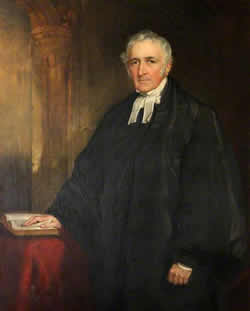 |
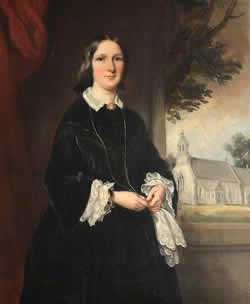 |
|
| Rev William Holland d. 1878 | Matilda Holland d. 1905 | |
| Erddig © National Trust | Erddig © National Trust |
William Holland senior and His brother John Holland Junior were joint administrators of their father’s will following the decease of their brother Thomas before he had completed the task. They also administered the effects of their brother Thomas (Coed Coch MSS 3091):
“Account of John Holland esq. and the Rev. William Holland, (administrators of the late Thomas Holland, and also administrators 'de bonis', now with the Will annexed, of John Holland, deceased), with John Oldfield, touching their respective administrations subsequent to the settlement which took place after the death of Thomas Holland.
Related Titles: Coed Coch and Trovarth Estate Records, Creation Date: 1796-1817”.
John senior left bequests of £800 to each of his surviving children in his will dated 1780, and appointed Edward Kynaston and Richard Garmon as his executors. By the time of his decease in 1796 his son Robert was ill and unlikely to survive, he therefore added a codicil to his will including his grandson John Holland of Penmorfa in his bequests, and naming his son Thomas Holland as his executor. The will is endorsed with an amendment dated 14th December 1804 to the effect that Thomas Holland had died without completing the administration of John the elder’s will, and naming John the younger and his brother William as executors.
Surprisingly, from an entry in William’s diary, he appeared to believe that the Hollands of Kinmel were descended from the Duke of Exeter, in spite of the fact that his ancestors refuted Sir Thomas Holland of Berw’s claim to this at the time, this being endorsed by the College of Arms. (See Plas Berw Hollands).
Thursday, March 17, 1802, extract from a letter from his niece Holland to his daughter Margaret- “—my eldest niece a young heiress of two thousand per annum was certain to be married to Mr Wynne of Coed Coch. I like Mr Wynne very well as a gentleman of good principles and fortune, but there is a madness in the family, and that my niece a young heiress of £2000 per annum should give herself, her name and her fortune to a man of this description is to me mortifying to a degree. Yet my brother and his wife approve the match very much. The name of Holland will be gone from Wales in a very short time. It was originally English. There is a place in Lancashire called Holland whence the name was originally taken. A branch of the family was made Duke of Exeter and two sons of the Duke of Exeter, in troublesome times, about the time of Edward the Fourth, fled into Wales. They were of a Lancastrian party. They lived for some time in obscurity, till affairs brought better aspect for their family and then they became known and one of them became known and one of them settled in Wales by marrying the heiress of Kinmael from whence our family and the Hollands of Wales are descended. I have written a full account of this on the white leaves in my large Family Bible”.
There is no evidence of any descendants of the Duke of Exeter as described in the above diary entry, and assumption is not supported by the facts or the time lime from the Duke of Exeter.
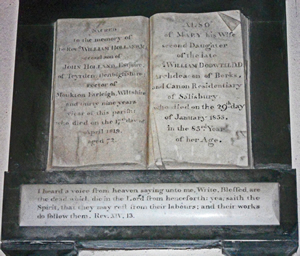 |
William senior died in 1819, his wife Mary outliving him by 14 years. Pictured left is the memorial to them in the church at Over Stowey in Somerset. |
|
Thomas ap John ap Thomas ap John ap Thomas ap Humphrey ap John ap Humphrey ap Piers ap John ap Dafydd ap Gruffudd ap Dafydd Holland, b1753 d circa 1797-1796, Gent. Thomas was born in 1753 (Llanelian PR’s). In the following Coed Coch MSS 2554, dated 1788 he is said to be of Manchester, there is no information regarding his occupation there, and no evidence that he ever married. Gfs p102 assumes he died without issue:
“Deed whereby Thomas Holland of Manchester, co. Lancaster, gentleman, administrator of the goods, etc., of the late John Holland of Teyrdan, co. Denbigh, his late father, deceased, releases to John Holland of Brynesteddfod, same co., the messuage, tenements, lands, etc. specified in No. 2526 for the payment of the sum of £1260 due in accordance with the terms of the mortgage thereupon, executed as in no. 2526. Signature and seal of Thomas Holland. Witnesses: Rowel Williams of Llanrwst, Hugh Hughes, his clerk. Endorsed with receipt by Thos. Holland from John Holland, for the consideration money, £1260. Signed and attested as above."
Related Titles: Coed Coch and Trovarth Estate Records, Creation Date: 1788, March 25.”
The following Coed Coch MSS 3085 suggests he died in 1796-98, a burial record in the Llanelian PR, 1796 confirms this.
Coed Coch and Trovarth Estate Records: Account of John Holland concerning the Estate of the lateThomas Holland, Is Part Of: Coed Coch and Trovarth Estate Records
Related Titles: Coed Coch and Trovarth Estate Records, Creation Date: 1796-1798”.
Jeffrey ap John ap Thomas ap John ap Thomas ap Humphrey ap John ap Humphrey ap Piers ap John ap Dafydd ap Gruffudd ap Dafydd Holland, b1756 . Jeffrey was born in 1756 (Llanelian PR). He also took holy orders and became vicar of Penmorfa and Dolbenmaen in Caernarfonshire. The following extract from William Holland’s diary indicates that he was of doubtful character inspite of his clerical status- Dec 7th 1801;
“I had a very restless night last night, my graet toe very painful (he suffered with gout). We received many letters with the papers on Sunday which I should have noted yesterday. One from my brother Jeffrey, Rector of Penmorfa---- Jeffrey was bred to the sea and I wish he had continued thus for he is very unfit to be a clergyman, a man of no principle, unfortunate in his marriage and dissolute and even desperate in his manners. He has wasted away considerable property and what will become of him at last I know not. ---“.
Presumably he squandered the £800 he had been bequeathed in his farther’s will. In 1777 Jeffrey married Margaret Royle of Gwydir, Llanrwst. It is probable that they had a son John, as the codicil to his father John’s will left the property in Llysfaen that he had previously bequeathed to his ailing son Robert, to his grandson John Holland of Penmorfa. He had not mentioned any grandchildren in his original will; John was either not yet born, or otherwise an infant. By 1786, when John added the codicil, John ap Jeffrey would still have been a minor, his only other surviving grandchildren were Mary, daughter of his elder son John and Margaret the infant daughter of his son Wiliam.
It is likely that John ap Jeffrey was born circa 1778-80, however there is no trace of him in any of the PR’s or 1841 census. Jeffrey’s wife Margaret died in 1812 as evidenced by her administration bond (SA/1812/78). Jeffrey Holland of Dolbenmaen in the Parish of Dolbenmaen, lawful husband and sole next-of-kin of Margaret Holland of Fynnoneilian, Llanelian yn Rhos, was named as administrator of her goods, cattels and chattels. It was unusual for a wife to have an administration bond whilst her husband was still living, the fact that they were clearly living in different places would suggest that they were estranged which is supported by his brother William’s diary comment.
Jeffrey petitioned to absolve himself of the duties of administrator on the grounds that the distance of his parish of Dolbenmaen from that of Llanelian made it impractical for him to perform his duties, he had to sign an oath to the effect that his wife’s possessions amounted to less than £100 before he could be relieved. A copy of this oath is attached to the bond. The fact that he was stated as being sole next-of- kin of Margaret would suggest that his son John was by then deceased. There is no record of Jeffrey’s death in the PR’s.
Robert ap John ap Thomas ap John ap Thomas ap Humphrey ap John ap Humphrey ap Piers ap John ap Dafydd ap Gruffudd ap Dafydd Holland, b1758, d1786. Robert was born in 1758 and died in 1786, the same year as his father (Llanelian PR’s). In his will, John had left a bequest of £800 and a tenement and lands in Llysfaen to Robert. In 1786 a codicil was added stating that due to the fact that Robert was ill and unlikely to recover his legacy was to be bequeathed instead to John’s grandson John Holland of Penmorfa (See above). Robert died shortly thereafter and it is assumed he did not marry.
Anne fch John ap Thomas ap John ap Thomas ap Humphrey ap John ap Humphrey ap Piers ap John ap Dafydd ap Gruffudd ap Dafydd Holland, b1760, d1763. Anne was born in 1760 and died an infant in 1763 (Llanelian PR).
Margaret fch John ap Thomas ap John ap Thomas ap Humphrey ap John ap Humphrey ap Piers ap John ap Dafydd ap Gruffudd ap Dafydd Holland, b17??, d1786. There is no birth record in the Llanelian PR, she was probably born between 1744 and 1753 where there is a gap in the records, the burial of Margaret Holland of Teyrdan recorded in the 1786 Llanelian PR was probably her, presumably she died a spinster. She received a bequest of £800 in her father’s will but only outlived him by eight months, by which time the will was not yet probated.
John ap Thomas was HSD in 1751. He accumulated considerable wealth, bequeathing five legacies of £800 each to his surviving children in addition to numerous properties in Denbighshire, Flintshire and Caernarfonshire.
John ap John ap Thomas ap John ap Thomas ap Humphrey ap John ap Humphrey ap Piers ap John ap Dafydd ap Gruffudd ap Dafydd Holland, b1744, d1784.
John was born in 1744, this being deduced from his epitaph in Llanelian church. According to Gfs, p102 he married Margaret Ellis of Plas Uchaf, daughter of John Ellis of Glan Y Wern, Mochdre, by Anne his second wife. His information is incorrect as Gfs appears to have got his John Ellis’ mixed up. The following deeds in the coed coch MSS show that he actually married Margaret fch John Ellis of Plas Uchaf in the neighbouring district of Llansanffraid Glan Conway;
“Deed tripartite made between (1) John Ellis of Plas Ucha. (ii) John Holland of Teirdarn (see No. 2403) and Robert Wynne of Garthmeilio, and (iii) Lewis Anwyl of Tai yn y foel, in the Parish of Cerrig yn Druidion, same co., and Mary Anwyl spinster, only daughters of the said Lewis Anwyl, being a settlement on the approaching marriage between the said J.Ellis and M. Anwyl, whereby the said J.Ellis conveys to the second party, for the benefit of the marrying parties, the capital messuage called Plas Ucha, and other properties as described in detail in the abovesaid deed (no. 2403), subject to specified reversions, remainders and conditions set forth at length. The marriage portion is £700, paid by J. Ellis to L. Anwyl. Signed by the 1st. Ellis, Lewis Anwyll and Mary Anwyll. Heraldic seal. Witnesses: Thomas Morgan, Havod Lea; Hugh Roberts Cerniego. John Ellis, Kyffdu. Endorsed with J. Ellis’s receipt to L. Anwyl for £700 consideration money. Date and attestation as above. Related Titles: Coed Coch and Trovarth Estate Records, Creation Date: 1754, March 26.”
The John Ellis, b1704 Llandrillo yn Rhos, referred to by Gfs, is probably the one who originally married Dorothy Lloyd circa 1725-27, by whom he had four children, Robert d1728, Margaret b1731, Robert b1733, d1738 and Thomas b1736. Dorothy died in 1737 and he married 2nd Margaret Holland of Llangelynnin in 1739, she in turn died in 1749 and there is no evidence of any issue from this marriage. He wasted no time as in 1750 he married Anne Jarvis, d/o William Jarvis of Llandrillo, Gent., and they had a son Robert b 1753, d1754 and a son John b 1755. John Ellis made what looks like a hasty will (SA/1758/46) in August 1754 two months after the death of his only son Robert by his wife Ann. What ever ailed him he must have soon recovered as his second son John was born in July 1755. John senior died in 1757 without making another will and he therefore left his property to his son Thomas and daughter Margaret by his previous wife Dorothy, there being no mention of his wife Anne. The will was contested presumably because it left nothing to John Junior or his wife Anne, and pending the outcome, his son Thomas as sole executor was bounden to administer his estate (SA/1757/55). The will was ultimately probated in 1758 without change.
The history of Plas Uchaf, Llansanffraid, Glan Conwy, has been published in an article by www.discoveringoldwelshouses.co.uk. Within it evidence is presented to show that John Holland junior of Teyrdan married Margaret fch John Ellis of Plas Uchaf and Mary Anwyl his wife as per the above Coed Coch MSS. It assumes that this John Ellis was the son of Robert Ellis s/o John Ellis of Glan Y Wern who died in 1757. However, we know this to be incorrect as both his sons named Robert died in infancy. It is quite plausible that this Robert Ellis was from Glan Y Wern, Llandrillo, but it is more likely that he was either a brother or cousin of the John Ellis who died in 1757. The following confirms a connection betweem the Glan Y Wern and Plas Uchaf families. In her will (SA/1766/70) Mary Jarvis, mother of Anne, the wife of John Ellis of Glan Y Wern, metioned as a potential beneficiary Grace, wife of Maurice Ellis of Llansanffraid Glan Conwy (Maurice Ellis married Grace Ellis in 1755). In 1751 Grace Ellis was named as the sister and next of kin of Robert Ellis, of Llansanffraid, Gent., in his administration bond (SA/1751/64). Also in her will Anne Ellis, widow of John Ellis of Glan Y Wern left a bequest to John Ellis s/o Maurice Ellis of Llansanfraidd. In her will, Mary Jarvis also left a provisional bequest to Catherine wife of Owen Holland of Newmarket who was the cousin of Margaret Holland of Llangelynnin, John Ellis’s 2nd wife, thereby making a connection between the Hollands of Llangelynnin and the Jarvis and Ellis families of Llandrillo and Llansanffrid Glan Conwy, and the Holland family of Teyrdan.
John and Margaret had two daughters, Mary and Margaret. Due to lack of male heirs, like Faerdref, Kinmel, Hendre Fawr and Wickwer before, the estate finaly went out of the Holland family ending a 400-year occupation of these substantial land holdings in Denbighshire.
John died in 1824. The following is a summary of his will (PROB1/1695):
Probate Copy of the Will of John Holland of Teyrdan, co. Denbigh, esq., wherein he bequeaths a messuage or tenement with lands in the Parish of Llanelian-in-Rhos, co. Denbigh, to his wife, Margaret Holland, for life, then to his grandson, William Holland Wynne Holland, second son of his (the testator's) daughter, Mary Lloyd Wynne, wife of John Lloyd Wynne, and disposes the dealings in respect of property in the parishes of Eglwysfach, Llansaintfraid Glan-Conway, and Llanelian-in-Rhos, and messuages called Brynrhyd and Ffrithlwyd in Eglwysfach. Signed by the testator. Attested by Edward Oldfield, attorney, Farm; J. Oldfield; oOhn Parry of Llanelian. Attached to the above is the document of the Letters of Administration by Charles [Manners Sutton], Archbishop of Canterbury, granted by the Rt. Hon. Sir John Nicholl, Knt., LL.D., Commissary of the Prerogative Court of Canterbury; to Margaret Holland, widow, relict of the testator. Dated 19 February, 1825. Seal of the Prerogative Court of the Archbishop of Canterbury.
Related Titles: Coed Coch and Trovarth Estate Records,
Margaret died in 1833, in her will (PROB11/1831) she left bequests to her grandson John Lloyd Wynne, daughter Mary Wynne, granddaughters Elizabeth and Anne Yorke, William Holland of Cold Norton, Essex and his sister Margaret of Bath and son-in-law John Lloyd Wynne Esq.
Mary fch John ap John ap Thomas ap John ap Thomas ap Humphrey ap John ap Humphrey ap Piers ap John ap Dafydd ap Gruffudd ap Dafydd Holland, b1777, 1844. Mary was the eldest daughter being born in 1777 (Bettws Yn Rhos PR). She married John Lloyd Wynne of Coed Coch in 1803 and they had three children in the space of three years between 1807 and 1809 and none thereafter. The eldest son John Lloyd Wynne (b1807) married Mary Anne Frances Haggit of Ditton, Cambridge in 1833, and they had three children, their son Edward William Wynne of Coed Coch married Anne Gwendoline Hughes, d/o Hugh Robert Hughes of Kinmel Park which had once been the estate of Mary Holland’s ancestors. Their son William was born in 1809 and died unmarried in 1833. Their daughter Mary was born in 1808 and she married Richard Lloyd Edwards of Nanhoran Ucha and they had 6 children (See Gfs p102 and 161).
Margaret fch John ap John ap Thomas ap John ap Thomas ap Humphrey ap John ap Humphrey ap Piers ap John ap Dafydd ap Gruffudd ap Dafydd Holland, b1778, d1848. Margaret was born in 1778 (Bettws Yn Rhos PR). In 1807 she married Simon Yorke of Erddig, near Wrexham. They had a son Simon who inherited the estate of Erddig. After the decease of her husband in 1834 her son presumably took possession of Erddig as evidenced by the 1841 census. Margaret does not appear anywhere in the 1841 census, according to her burial record in 1848 she was resident at Hinton Admiral, Nr Southamton at the time of her decease. (Marchweil PR).
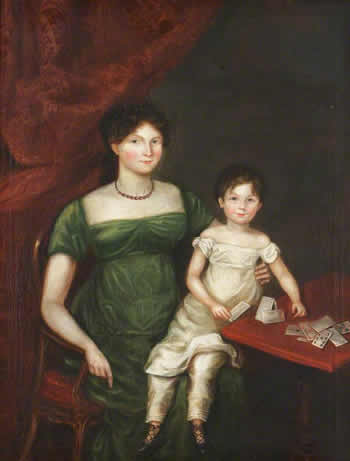 |
Erddig is now owned by the National Trust. Adjacent is a painting of Margaret and her daughter Anne Yorke which hangs in one of the rooms there, and below are the arms of Yorke and Holland. | ||
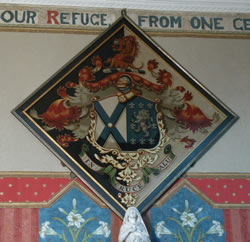 |
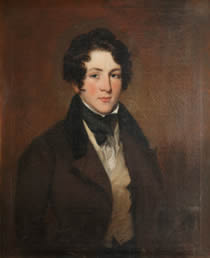 |
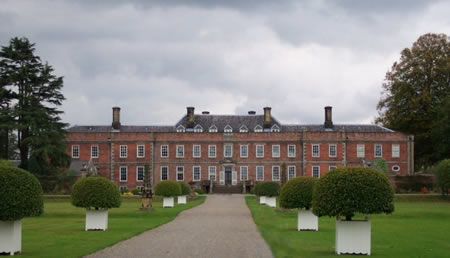 |
||
| Simon Yorke 2nd son of Phillip & Margaret | Erddig Hall | ||
Margaret and Simon had three other children, Anne b 1810, Ethelred b 1812 and John b1814 (Gresford PR).
Pedigree
The pedigree below follows the descendants of Gruffudd Holland over a period of four hundred years, during which time many of the main male lines held positions of authority in Denbighshire and to a lesser extent Flintshire. Strategic marriages with other prominent families enabled them to acquire large estates in Denbighshire which regrettably, progressively went out of the Holland family due to a lack of male heirs. From the available parish records of the 17th and 18th centuries it is apparent that there were a significant number of Holland entries, the origins of whom have proved impossible to trace.
Additionally, there are several males on the pedigree whose existence we can establish but whose subsequent history has proved untraceable. It seems highly likely that some of those Hollands in the PR’s are descended from one or more of the Abergele, Kimnel, Llanelian or Wickwer lines, however, it has so far proved impossible to trace their origins.
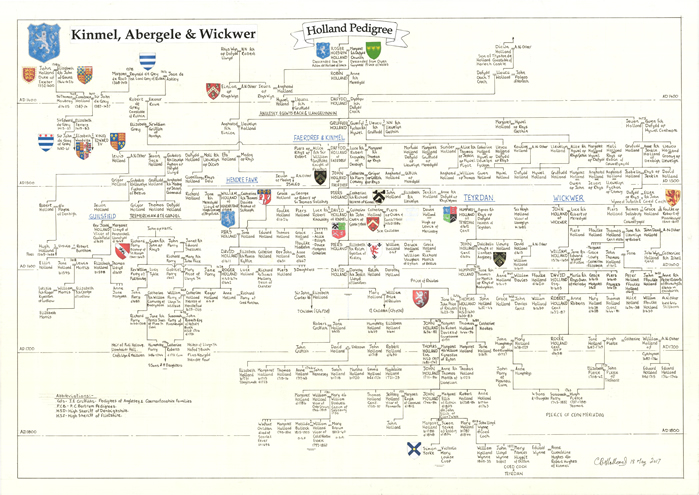 |
| Kinmel, Abergele & Wickwer Pedigree (click to enlarge in pdf format) |
Copyright Paul Holland © 2006 - 2022 All rights reserved. Permission is granted for all free personal and non-commercial uses. Sources are available on request. |


